Influence of External Factors on Business Success
VerifiedAdded on 2020/01/28
|22
|6046
|312
Essay
AI Summary
This assignment delves into the significant impact of external factors on business performance. It examines how technological advancements, environmental regulations, political climate, and socio-economic trends influence organizational growth and sustainability. The analysis draws upon various theoretical frameworks like the Technology-Organization-Environment (TOE) framework and emphasizes the importance of strategic adaptation in navigating these dynamic external forces.
Contribute Materials
Your contribution can guide someone’s learning journey. Share your
documents today.
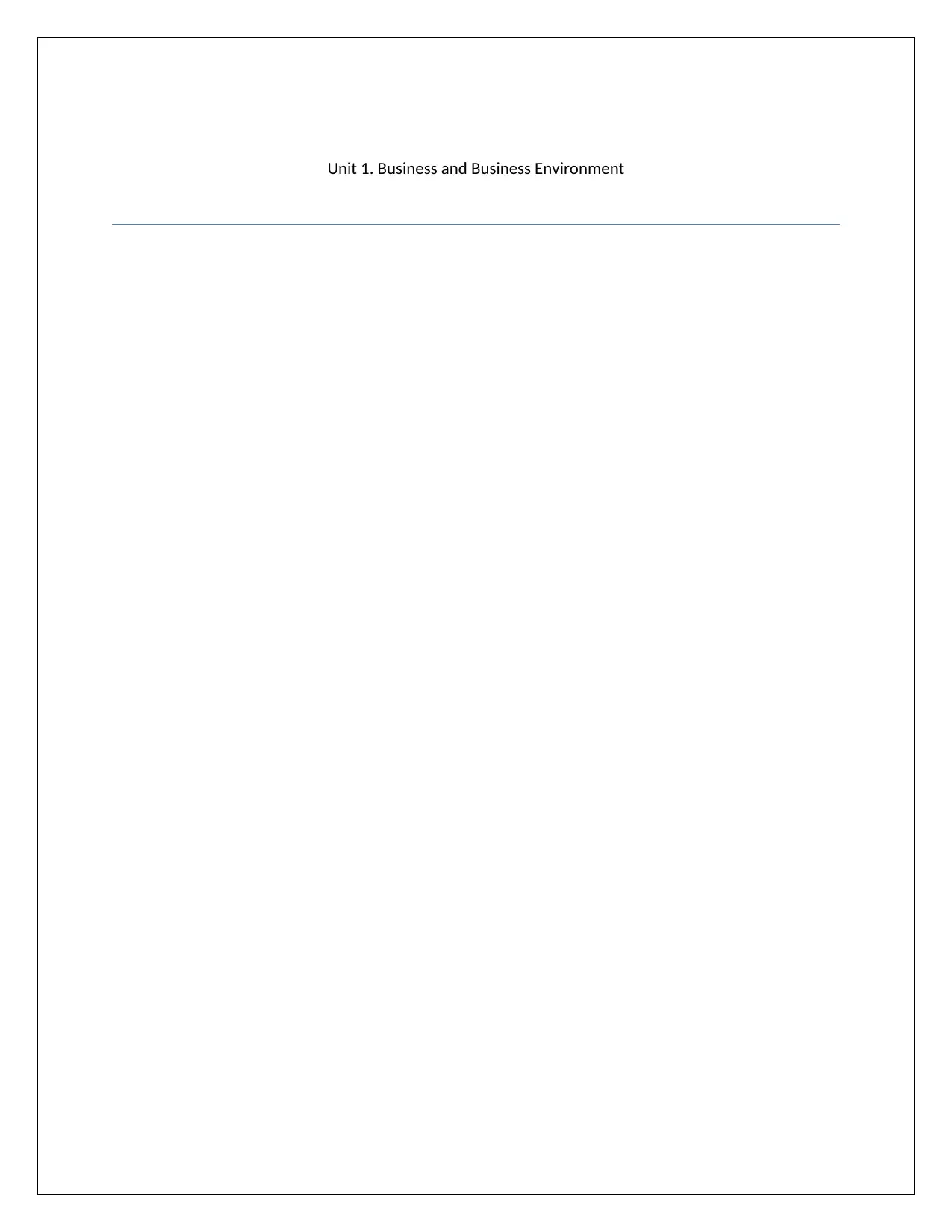
Unit 1. Business and Business Environment
Secure Best Marks with AI Grader
Need help grading? Try our AI Grader for instant feedback on your assignments.
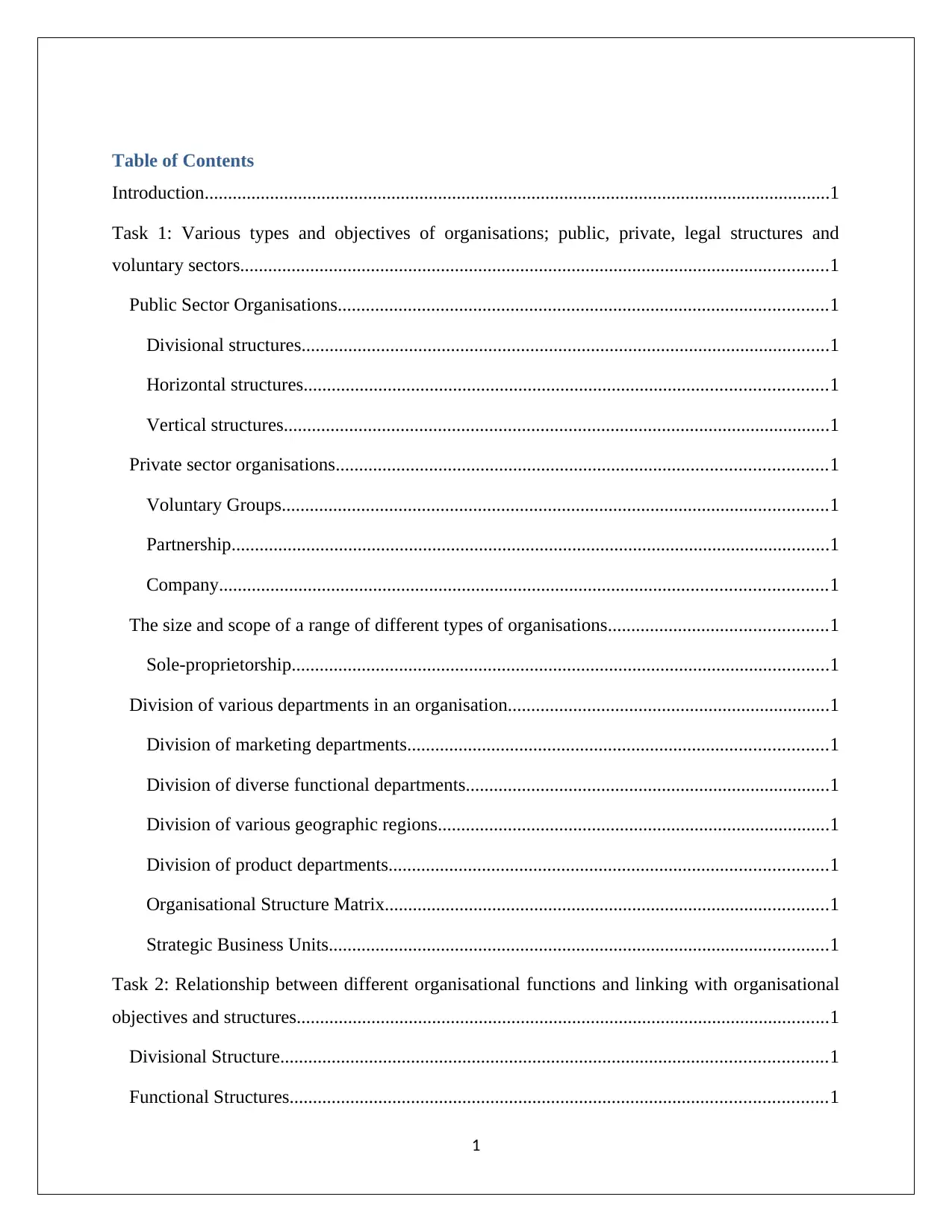
Table of Contents
Introduction......................................................................................................................................1
Task 1: Various types and objectives of organisations; public, private, legal structures and
voluntary sectors..............................................................................................................................1
Public Sector Organisations.........................................................................................................1
Divisional structures.................................................................................................................1
Horizontal structures................................................................................................................1
Vertical structures.....................................................................................................................1
Private sector organisations.........................................................................................................1
Voluntary Groups.....................................................................................................................1
Partnership................................................................................................................................1
Company..................................................................................................................................1
The size and scope of a range of different types of organisations...............................................1
Sole-proprietorship...................................................................................................................1
Division of various departments in an organisation.....................................................................1
Division of marketing departments..........................................................................................1
Division of diverse functional departments..............................................................................1
Division of various geographic regions....................................................................................1
Division of product departments..............................................................................................1
Organisational Structure Matrix...............................................................................................1
Strategic Business Units...........................................................................................................1
Task 2: Relationship between different organisational functions and linking with organisational
objectives and structures..................................................................................................................1
Divisional Structure.....................................................................................................................1
Functional Structures...................................................................................................................1
1
Introduction......................................................................................................................................1
Task 1: Various types and objectives of organisations; public, private, legal structures and
voluntary sectors..............................................................................................................................1
Public Sector Organisations.........................................................................................................1
Divisional structures.................................................................................................................1
Horizontal structures................................................................................................................1
Vertical structures.....................................................................................................................1
Private sector organisations.........................................................................................................1
Voluntary Groups.....................................................................................................................1
Partnership................................................................................................................................1
Company..................................................................................................................................1
The size and scope of a range of different types of organisations...............................................1
Sole-proprietorship...................................................................................................................1
Division of various departments in an organisation.....................................................................1
Division of marketing departments..........................................................................................1
Division of diverse functional departments..............................................................................1
Division of various geographic regions....................................................................................1
Division of product departments..............................................................................................1
Organisational Structure Matrix...............................................................................................1
Strategic Business Units...........................................................................................................1
Task 2: Relationship between different organisational functions and linking with organisational
objectives and structures..................................................................................................................1
Divisional Structure.....................................................................................................................1
Functional Structures...................................................................................................................1
1
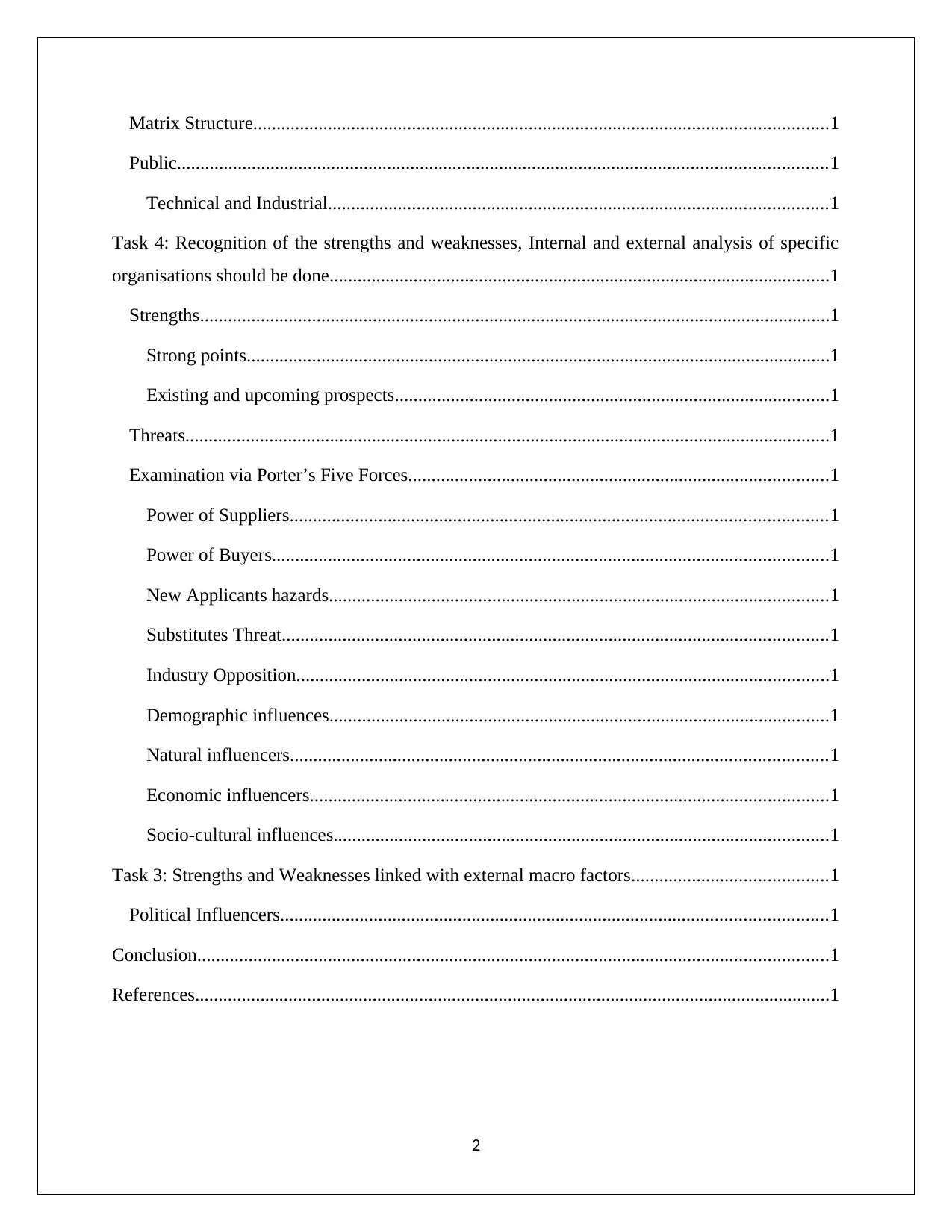
Matrix Structure...........................................................................................................................1
Public...........................................................................................................................................1
Technical and Industrial...........................................................................................................1
Task 4: Recognition of the strengths and weaknesses, Internal and external analysis of specific
organisations should be done...........................................................................................................1
Strengths.......................................................................................................................................1
Strong points.............................................................................................................................1
Existing and upcoming prospects.............................................................................................1
Threats..........................................................................................................................................1
Examination via Porter’s Five Forces..........................................................................................1
Power of Suppliers...................................................................................................................1
Power of Buyers.......................................................................................................................1
New Applicants hazards...........................................................................................................1
Substitutes Threat.....................................................................................................................1
Industry Opposition..................................................................................................................1
Demographic influences...........................................................................................................1
Natural influencers...................................................................................................................1
Economic influencers...............................................................................................................1
Socio-cultural influences..........................................................................................................1
Task 3: Strengths and Weaknesses linked with external macro factors..........................................1
Political Influencers.....................................................................................................................1
Conclusion.......................................................................................................................................1
References........................................................................................................................................1
2
Public...........................................................................................................................................1
Technical and Industrial...........................................................................................................1
Task 4: Recognition of the strengths and weaknesses, Internal and external analysis of specific
organisations should be done...........................................................................................................1
Strengths.......................................................................................................................................1
Strong points.............................................................................................................................1
Existing and upcoming prospects.............................................................................................1
Threats..........................................................................................................................................1
Examination via Porter’s Five Forces..........................................................................................1
Power of Suppliers...................................................................................................................1
Power of Buyers.......................................................................................................................1
New Applicants hazards...........................................................................................................1
Substitutes Threat.....................................................................................................................1
Industry Opposition..................................................................................................................1
Demographic influences...........................................................................................................1
Natural influencers...................................................................................................................1
Economic influencers...............................................................................................................1
Socio-cultural influences..........................................................................................................1
Task 3: Strengths and Weaknesses linked with external macro factors..........................................1
Political Influencers.....................................................................................................................1
Conclusion.......................................................................................................................................1
References........................................................................................................................................1
2
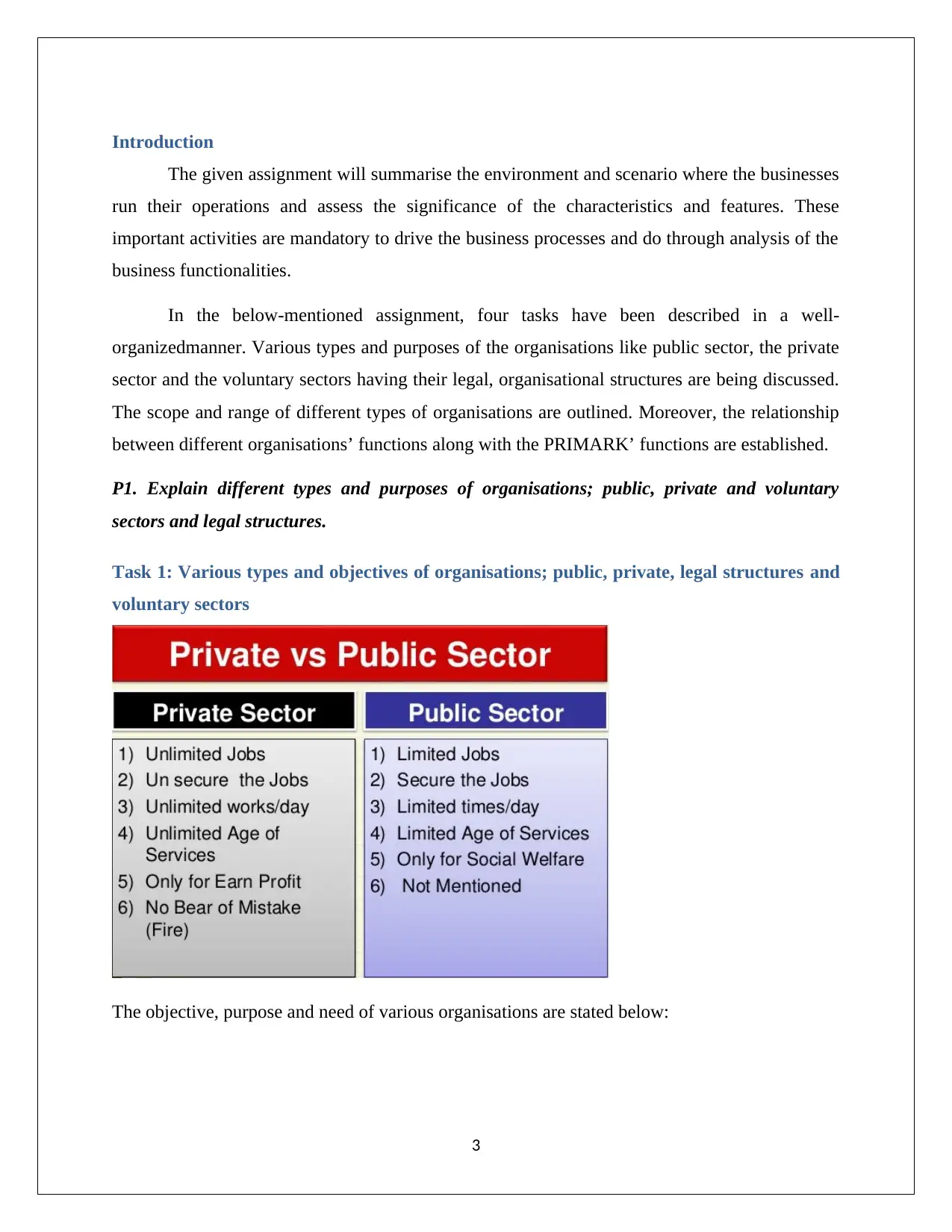
Introduction
The given assignment will summarise the environment and scenario where the businesses
run their operations and assess the significance of the characteristics and features. These
important activities are mandatory to drive the business processes and do through analysis of the
business functionalities.
In the below-mentioned assignment, four tasks have been described in a well-
organizedmanner. Various types and purposes of the organisations like public sector, the private
sector and the voluntary sectors having their legal, organisational structures are being discussed.
The scope and range of different types of organisations are outlined. Moreover, the relationship
between different organisations’ functions along with the PRIMARK’ functions are established.
P1. Explain different types and purposes of organisations; public, private and voluntary
sectors and legal structures.
Task 1: Various types and objectives of organisations; public, private, legal structures and
voluntary sectors
The objective, purpose and need of various organisations are stated below:
3
The given assignment will summarise the environment and scenario where the businesses
run their operations and assess the significance of the characteristics and features. These
important activities are mandatory to drive the business processes and do through analysis of the
business functionalities.
In the below-mentioned assignment, four tasks have been described in a well-
organizedmanner. Various types and purposes of the organisations like public sector, the private
sector and the voluntary sectors having their legal, organisational structures are being discussed.
The scope and range of different types of organisations are outlined. Moreover, the relationship
between different organisations’ functions along with the PRIMARK’ functions are established.
P1. Explain different types and purposes of organisations; public, private and voluntary
sectors and legal structures.
Task 1: Various types and objectives of organisations; public, private, legal structures and
voluntary sectors
The objective, purpose and need of various organisations are stated below:
3
Secure Best Marks with AI Grader
Need help grading? Try our AI Grader for instant feedback on your assignments.
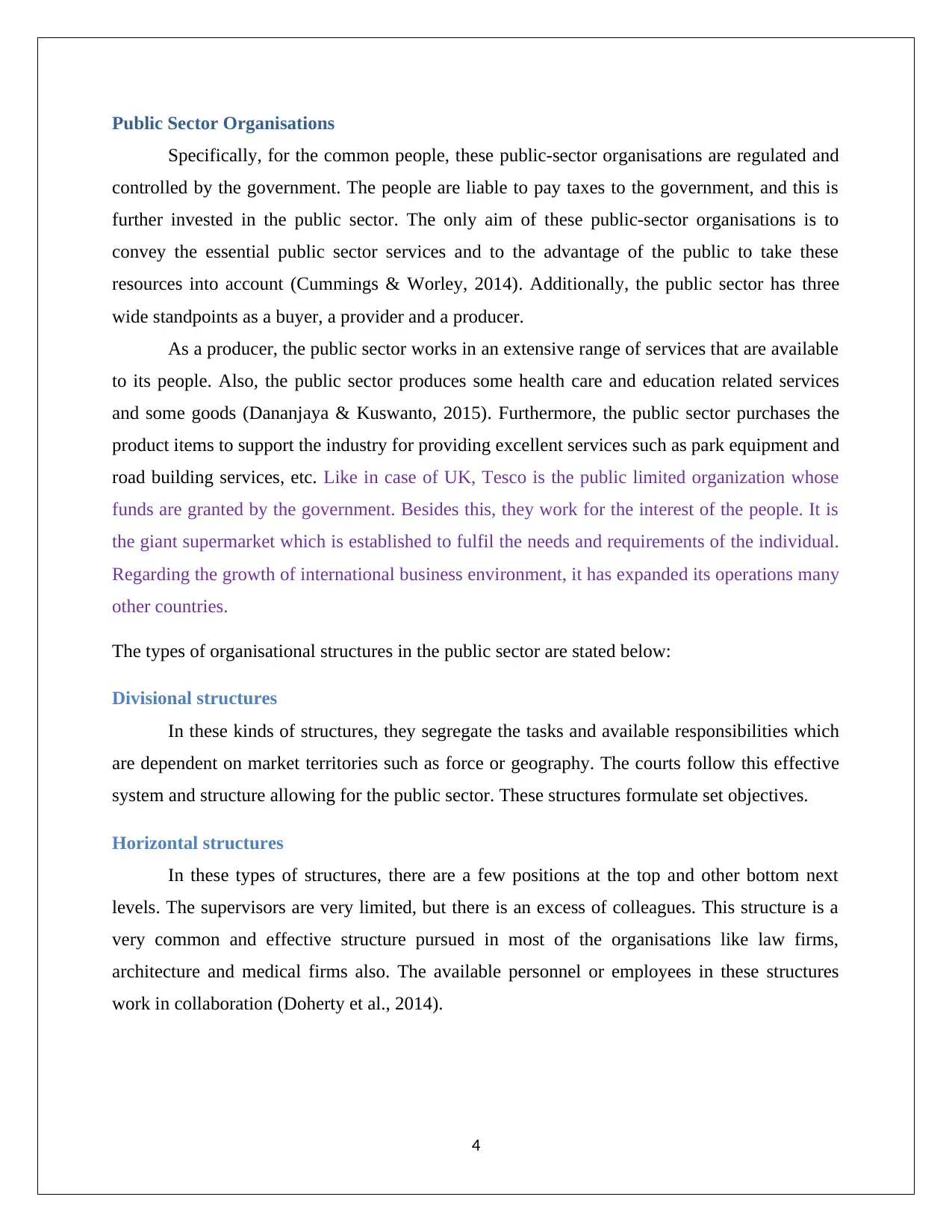
Public Sector Organisations
Specifically, for the common people, these public-sector organisations are regulated and
controlled by the government. The people are liable to pay taxes to the government, and this is
further invested in the public sector. The only aim of these public-sector organisations is to
convey the essential public sector services and to the advantage of the public to take these
resources into account (Cummings & Worley, 2014). Additionally, the public sector has three
wide standpoints as a buyer, a provider and a producer.
As a producer, the public sector works in an extensive range of services that are available
to its people. Also, the public sector produces some health care and education related services
and some goods (Dananjaya & Kuswanto, 2015). Furthermore, the public sector purchases the
product items to support the industry for providing excellent services such as park equipment and
road building services, etc. Like in case of UK, Tesco is the public limited organization whose
funds are granted by the government. Besides this, they work for the interest of the people. It is
the giant supermarket which is established to fulfil the needs and requirements of the individual.
Regarding the growth of international business environment, it has expanded its operations many
other countries.
The types of organisational structures in the public sector are stated below:
Divisional structures
In these kinds of structures, they segregate the tasks and available responsibilities which
are dependent on market territories such as force or geography. The courts follow this effective
system and structure allowing for the public sector. These structures formulate set objectives.
Horizontal structures
In these types of structures, there are a few positions at the top and other bottom next
levels. The supervisors are very limited, but there is an excess of colleagues. This structure is a
very common and effective structure pursued in most of the organisations like law firms,
architecture and medical firms also. The available personnel or employees in these structures
work in collaboration (Doherty et al., 2014).
4
Specifically, for the common people, these public-sector organisations are regulated and
controlled by the government. The people are liable to pay taxes to the government, and this is
further invested in the public sector. The only aim of these public-sector organisations is to
convey the essential public sector services and to the advantage of the public to take these
resources into account (Cummings & Worley, 2014). Additionally, the public sector has three
wide standpoints as a buyer, a provider and a producer.
As a producer, the public sector works in an extensive range of services that are available
to its people. Also, the public sector produces some health care and education related services
and some goods (Dananjaya & Kuswanto, 2015). Furthermore, the public sector purchases the
product items to support the industry for providing excellent services such as park equipment and
road building services, etc. Like in case of UK, Tesco is the public limited organization whose
funds are granted by the government. Besides this, they work for the interest of the people. It is
the giant supermarket which is established to fulfil the needs and requirements of the individual.
Regarding the growth of international business environment, it has expanded its operations many
other countries.
The types of organisational structures in the public sector are stated below:
Divisional structures
In these kinds of structures, they segregate the tasks and available responsibilities which
are dependent on market territories such as force or geography. The courts follow this effective
system and structure allowing for the public sector. These structures formulate set objectives.
Horizontal structures
In these types of structures, there are a few positions at the top and other bottom next
levels. The supervisors are very limited, but there is an excess of colleagues. This structure is a
very common and effective structure pursued in most of the organisations like law firms,
architecture and medical firms also. The available personnel or employees in these structures
work in collaboration (Doherty et al., 2014).
4
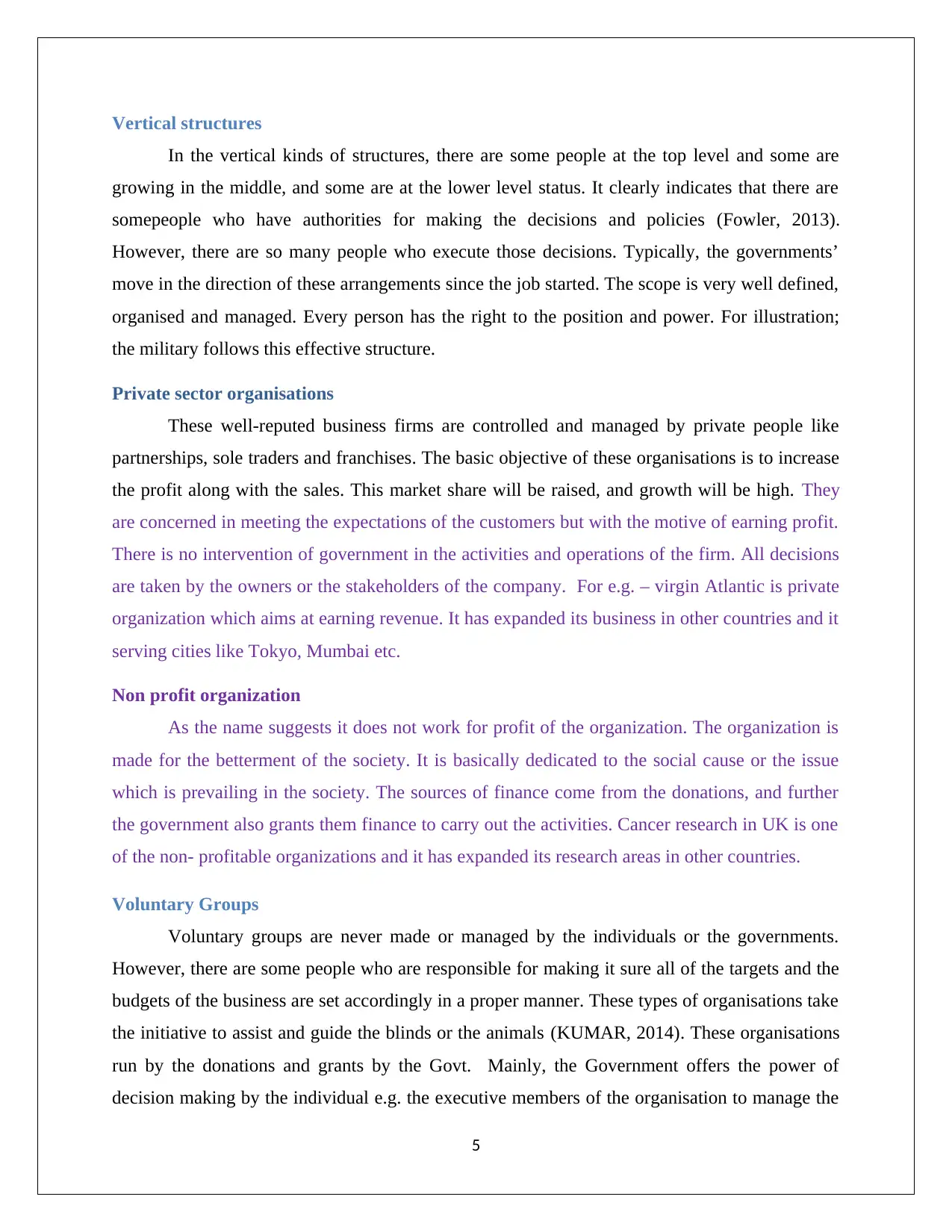
Vertical structures
In the vertical kinds of structures, there are some people at the top level and some are
growing in the middle, and some are at the lower level status. It clearly indicates that there are
somepeople who have authorities for making the decisions and policies (Fowler, 2013).
However, there are so many people who execute those decisions. Typically, the governments’
move in the direction of these arrangements since the job started. The scope is very well defined,
organised and managed. Every person has the right to the position and power. For illustration;
the military follows this effective structure.
Private sector organisations
These well-reputed business firms are controlled and managed by private people like
partnerships, sole traders and franchises. The basic objective of these organisations is to increase
the profit along with the sales. This market share will be raised, and growth will be high. They
are concerned in meeting the expectations of the customers but with the motive of earning profit.
There is no intervention of government in the activities and operations of the firm. All decisions
are taken by the owners or the stakeholders of the company. For e.g. – virgin Atlantic is private
organization which aims at earning revenue. It has expanded its business in other countries and it
serving cities like Tokyo, Mumbai etc.
Non profit organization
As the name suggests it does not work for profit of the organization. The organization is
made for the betterment of the society. It is basically dedicated to the social cause or the issue
which is prevailing in the society. The sources of finance come from the donations, and further
the government also grants them finance to carry out the activities. Cancer research in UK is one
of the non- profitable organizations and it has expanded its research areas in other countries.
Voluntary Groups
Voluntary groups are never made or managed by the individuals or the governments.
However, there are some people who are responsible for making it sure all of the targets and the
budgets of the business are set accordingly in a proper manner. These types of organisations take
the initiative to assist and guide the blinds or the animals (KUMAR, 2014). These organisations
run by the donations and grants by the Govt. Mainly, the Government offers the power of
decision making by the individual e.g. the executive members of the organisation to manage the
5
In the vertical kinds of structures, there are some people at the top level and some are
growing in the middle, and some are at the lower level status. It clearly indicates that there are
somepeople who have authorities for making the decisions and policies (Fowler, 2013).
However, there are so many people who execute those decisions. Typically, the governments’
move in the direction of these arrangements since the job started. The scope is very well defined,
organised and managed. Every person has the right to the position and power. For illustration;
the military follows this effective structure.
Private sector organisations
These well-reputed business firms are controlled and managed by private people like
partnerships, sole traders and franchises. The basic objective of these organisations is to increase
the profit along with the sales. This market share will be raised, and growth will be high. They
are concerned in meeting the expectations of the customers but with the motive of earning profit.
There is no intervention of government in the activities and operations of the firm. All decisions
are taken by the owners or the stakeholders of the company. For e.g. – virgin Atlantic is private
organization which aims at earning revenue. It has expanded its business in other countries and it
serving cities like Tokyo, Mumbai etc.
Non profit organization
As the name suggests it does not work for profit of the organization. The organization is
made for the betterment of the society. It is basically dedicated to the social cause or the issue
which is prevailing in the society. The sources of finance come from the donations, and further
the government also grants them finance to carry out the activities. Cancer research in UK is one
of the non- profitable organizations and it has expanded its research areas in other countries.
Voluntary Groups
Voluntary groups are never made or managed by the individuals or the governments.
However, there are some people who are responsible for making it sure all of the targets and the
budgets of the business are set accordingly in a proper manner. These types of organisations take
the initiative to assist and guide the blinds or the animals (KUMAR, 2014). These organisations
run by the donations and grants by the Govt. Mainly, the Government offers the power of
decision making by the individual e.g. the executive members of the organisation to manage the
5
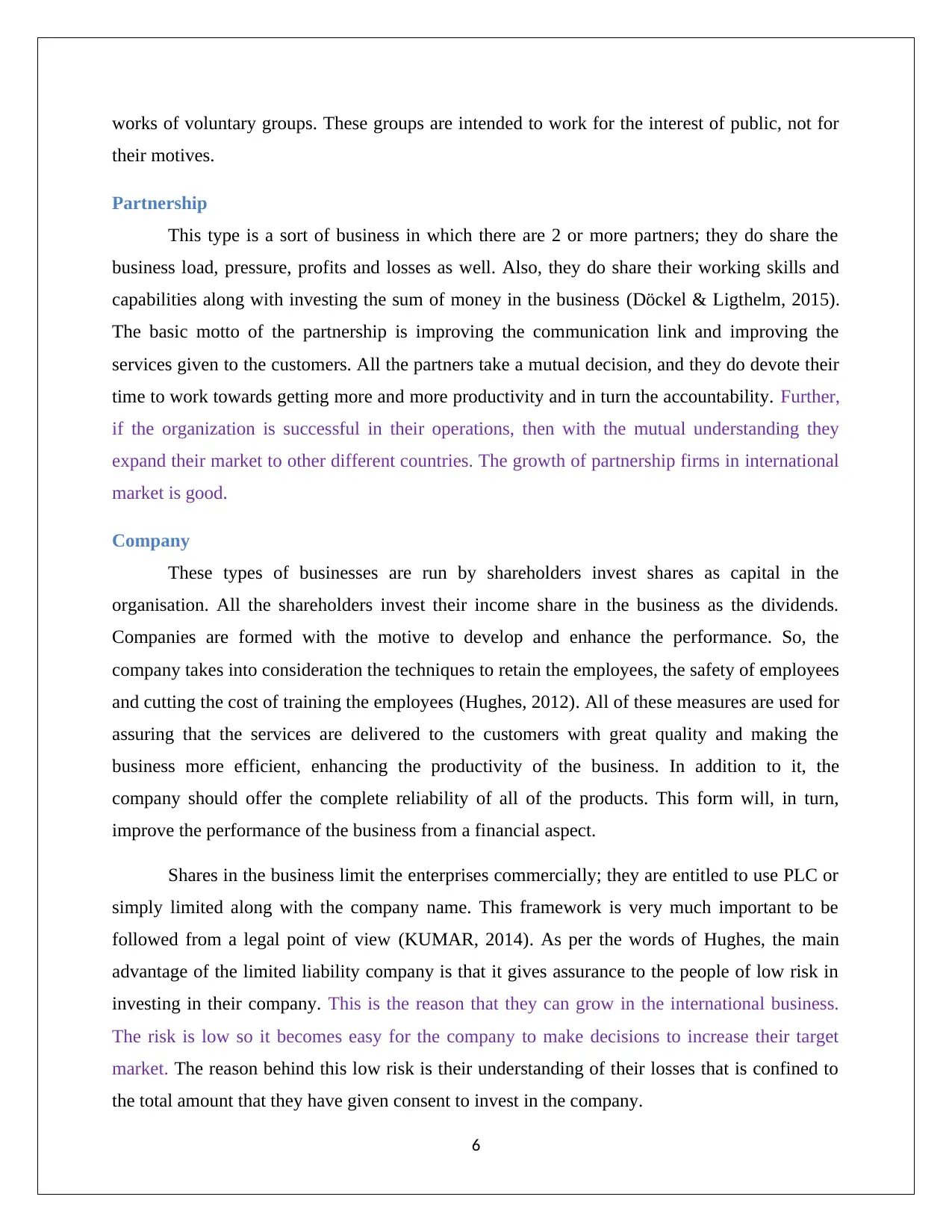
works of voluntary groups. These groups are intended to work for the interest of public, not for
their motives.
Partnership
This type is a sort of business in which there are 2 or more partners; they do share the
business load, pressure, profits and losses as well. Also, they do share their working skills and
capabilities along with investing the sum of money in the business (Döckel & Ligthelm, 2015).
The basic motto of the partnership is improving the communication link and improving the
services given to the customers. All the partners take a mutual decision, and they do devote their
time to work towards getting more and more productivity and in turn the accountability. Further,
if the organization is successful in their operations, then with the mutual understanding they
expand their market to other different countries. The growth of partnership firms in international
market is good.
Company
These types of businesses are run by shareholders invest shares as capital in the
organisation. All the shareholders invest their income share in the business as the dividends.
Companies are formed with the motive to develop and enhance the performance. So, the
company takes into consideration the techniques to retain the employees, the safety of employees
and cutting the cost of training the employees (Hughes, 2012). All of these measures are used for
assuring that the services are delivered to the customers with great quality and making the
business more efficient, enhancing the productivity of the business. In addition to it, the
company should offer the complete reliability of all of the products. This form will, in turn,
improve the performance of the business from a financial aspect.
Shares in the business limit the enterprises commercially; they are entitled to use PLC or
simply limited along with the company name. This framework is very much important to be
followed from a legal point of view (KUMAR, 2014). As per the words of Hughes, the main
advantage of the limited liability company is that it gives assurance to the people of low risk in
investing in their company. This is the reason that they can grow in the international business.
The risk is low so it becomes easy for the company to make decisions to increase their target
market. The reason behind this low risk is their understanding of their losses that is confined to
the total amount that they have given consent to invest in the company.
6
their motives.
Partnership
This type is a sort of business in which there are 2 or more partners; they do share the
business load, pressure, profits and losses as well. Also, they do share their working skills and
capabilities along with investing the sum of money in the business (Döckel & Ligthelm, 2015).
The basic motto of the partnership is improving the communication link and improving the
services given to the customers. All the partners take a mutual decision, and they do devote their
time to work towards getting more and more productivity and in turn the accountability. Further,
if the organization is successful in their operations, then with the mutual understanding they
expand their market to other different countries. The growth of partnership firms in international
market is good.
Company
These types of businesses are run by shareholders invest shares as capital in the
organisation. All the shareholders invest their income share in the business as the dividends.
Companies are formed with the motive to develop and enhance the performance. So, the
company takes into consideration the techniques to retain the employees, the safety of employees
and cutting the cost of training the employees (Hughes, 2012). All of these measures are used for
assuring that the services are delivered to the customers with great quality and making the
business more efficient, enhancing the productivity of the business. In addition to it, the
company should offer the complete reliability of all of the products. This form will, in turn,
improve the performance of the business from a financial aspect.
Shares in the business limit the enterprises commercially; they are entitled to use PLC or
simply limited along with the company name. This framework is very much important to be
followed from a legal point of view (KUMAR, 2014). As per the words of Hughes, the main
advantage of the limited liability company is that it gives assurance to the people of low risk in
investing in their company. This is the reason that they can grow in the international business.
The risk is low so it becomes easy for the company to make decisions to increase their target
market. The reason behind this low risk is their understanding of their losses that is confined to
the total amount that they have given consent to invest in the company.
6
Paraphrase This Document
Need a fresh take? Get an instant paraphrase of this document with our AI Paraphraser
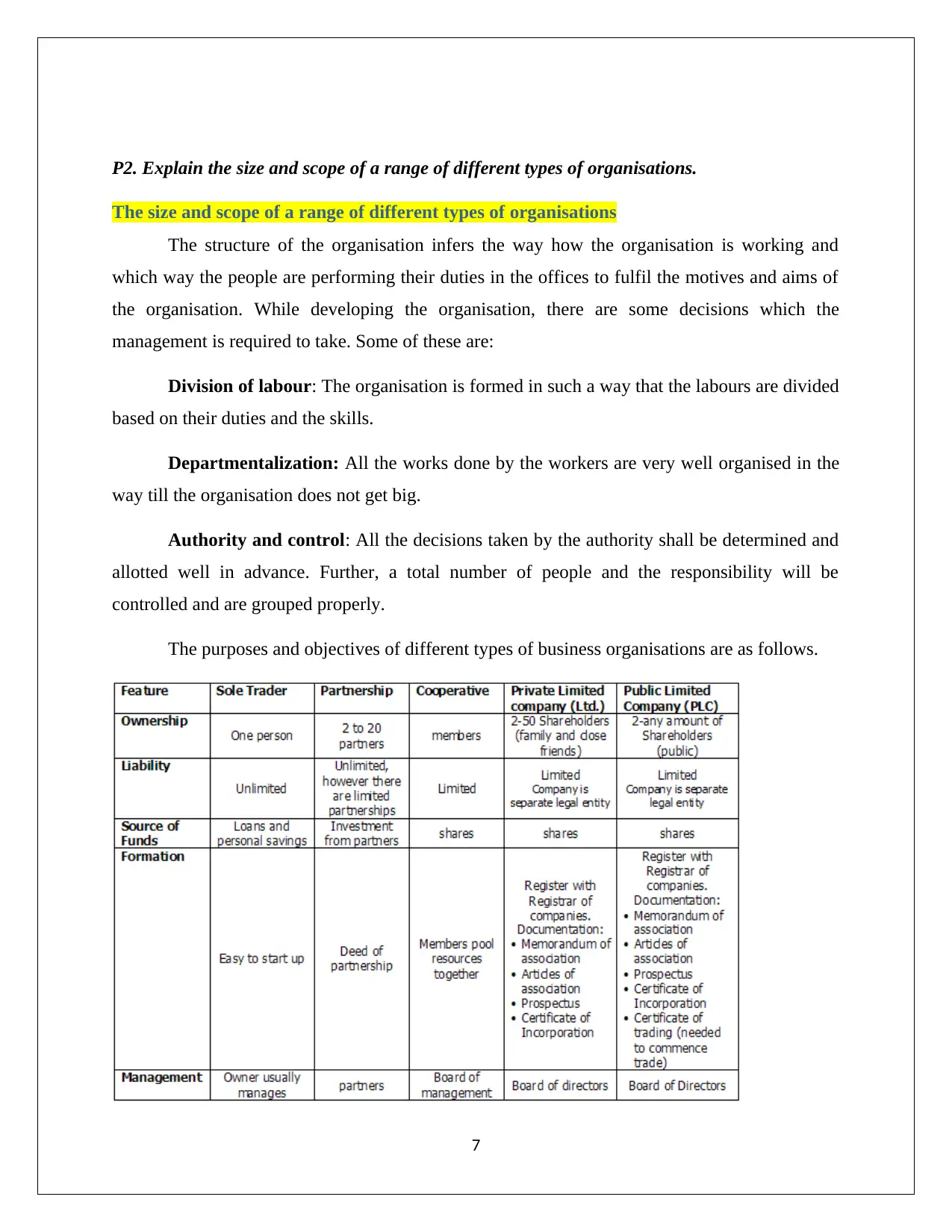
P2. Explain the size and scope of a range of different types of organisations.
The size and scope of a range of different types of organisations
The structure of the organisation infers the way how the organisation is working and
which way the people are performing their duties in the offices to fulfil the motives and aims of
the organisation. While developing the organisation, there are some decisions which the
management is required to take. Some of these are:
Division of labour: The organisation is formed in such a way that the labours are divided
based on their duties and the skills.
Departmentalization: All the works done by the workers are very well organised in the
way till the organisation does not get big.
Authority and control: All the decisions taken by the authority shall be determined and
allotted well in advance. Further, a total number of people and the responsibility will be
controlled and are grouped properly.
The purposes and objectives of different types of business organisations are as follows.
7
The size and scope of a range of different types of organisations
The structure of the organisation infers the way how the organisation is working and
which way the people are performing their duties in the offices to fulfil the motives and aims of
the organisation. While developing the organisation, there are some decisions which the
management is required to take. Some of these are:
Division of labour: The organisation is formed in such a way that the labours are divided
based on their duties and the skills.
Departmentalization: All the works done by the workers are very well organised in the
way till the organisation does not get big.
Authority and control: All the decisions taken by the authority shall be determined and
allotted well in advance. Further, a total number of people and the responsibility will be
controlled and are grouped properly.
The purposes and objectives of different types of business organisations are as follows.
7
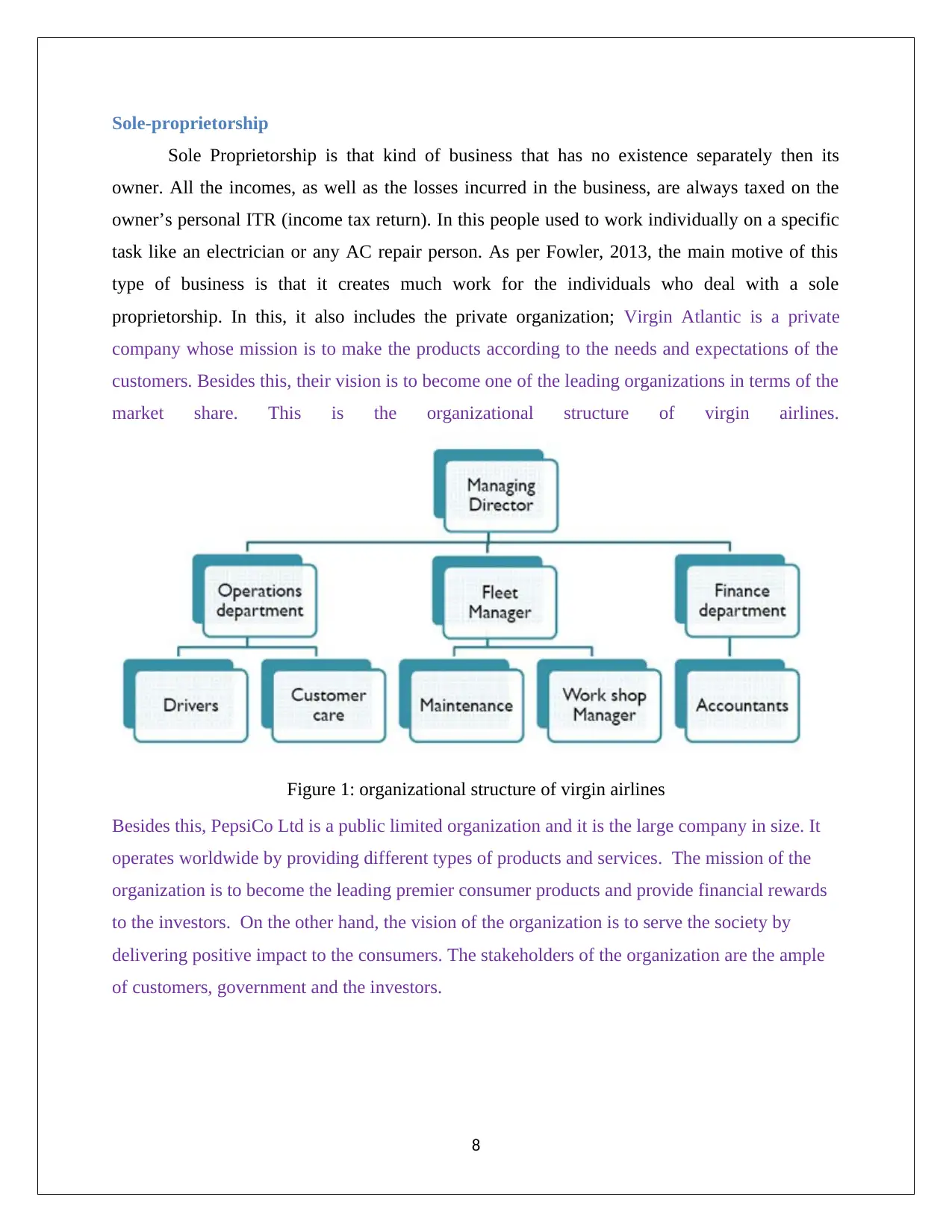
Sole-proprietorship
Sole Proprietorship is that kind of business that has no existence separately then its
owner. All the incomes, as well as the losses incurred in the business, are always taxed on the
owner’s personal ITR (income tax return). In this people used to work individually on a specific
task like an electrician or any AC repair person. As per Fowler, 2013, the main motive of this
type of business is that it creates much work for the individuals who deal with a sole
proprietorship. In this, it also includes the private organization; Virgin Atlantic is a private
company whose mission is to make the products according to the needs and expectations of the
customers. Besides this, their vision is to become one of the leading organizations in terms of the
market share. This is the organizational structure of virgin airlines.
Figure 1: organizational structure of virgin airlines
Besides this, PepsiCo Ltd is a public limited organization and it is the large company in size. It
operates worldwide by providing different types of products and services. The mission of the
organization is to become the leading premier consumer products and provide financial rewards
to the investors. On the other hand, the vision of the organization is to serve the society by
delivering positive impact to the consumers. The stakeholders of the organization are the ample
of customers, government and the investors.
8
Sole Proprietorship is that kind of business that has no existence separately then its
owner. All the incomes, as well as the losses incurred in the business, are always taxed on the
owner’s personal ITR (income tax return). In this people used to work individually on a specific
task like an electrician or any AC repair person. As per Fowler, 2013, the main motive of this
type of business is that it creates much work for the individuals who deal with a sole
proprietorship. In this, it also includes the private organization; Virgin Atlantic is a private
company whose mission is to make the products according to the needs and expectations of the
customers. Besides this, their vision is to become one of the leading organizations in terms of the
market share. This is the organizational structure of virgin airlines.
Figure 1: organizational structure of virgin airlines
Besides this, PepsiCo Ltd is a public limited organization and it is the large company in size. It
operates worldwide by providing different types of products and services. The mission of the
organization is to become the leading premier consumer products and provide financial rewards
to the investors. On the other hand, the vision of the organization is to serve the society by
delivering positive impact to the consumers. The stakeholders of the organization are the ample
of customers, government and the investors.
8
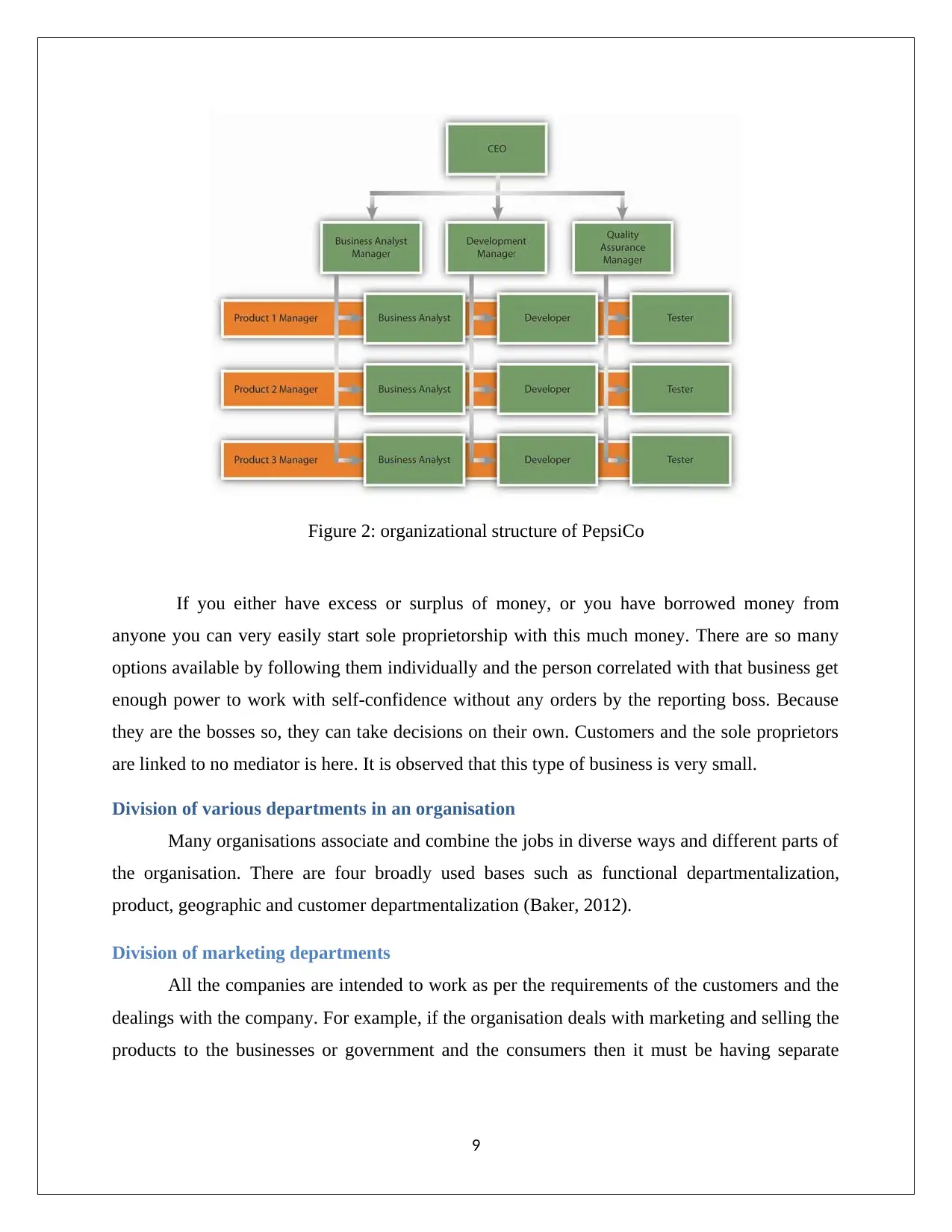
Figure 2: organizational structure of PepsiCo
If you either have excess or surplus of money, or you have borrowed money from
anyone you can very easily start sole proprietorship with this much money. There are so many
options available by following them individually and the person correlated with that business get
enough power to work with self-confidence without any orders by the reporting boss. Because
they are the bosses so, they can take decisions on their own. Customers and the sole proprietors
are linked to no mediator is here. It is observed that this type of business is very small.
Division of various departments in an organisation
Many organisations associate and combine the jobs in diverse ways and different parts of
the organisation. There are four broadly used bases such as functional departmentalization,
product, geographic and customer departmentalization (Baker, 2012).
Division of marketing departments
All the companies are intended to work as per the requirements of the customers and the
dealings with the company. For example, if the organisation deals with marketing and selling the
products to the businesses or government and the consumers then it must be having separate
9
If you either have excess or surplus of money, or you have borrowed money from
anyone you can very easily start sole proprietorship with this much money. There are so many
options available by following them individually and the person correlated with that business get
enough power to work with self-confidence without any orders by the reporting boss. Because
they are the bosses so, they can take decisions on their own. Customers and the sole proprietors
are linked to no mediator is here. It is observed that this type of business is very small.
Division of various departments in an organisation
Many organisations associate and combine the jobs in diverse ways and different parts of
the organisation. There are four broadly used bases such as functional departmentalization,
product, geographic and customer departmentalization (Baker, 2012).
Division of marketing departments
All the companies are intended to work as per the requirements of the customers and the
dealings with the company. For example, if the organisation deals with marketing and selling the
products to the businesses or government and the consumers then it must be having separate
9
Secure Best Marks with AI Grader
Need help grading? Try our AI Grader for instant feedback on your assignments.
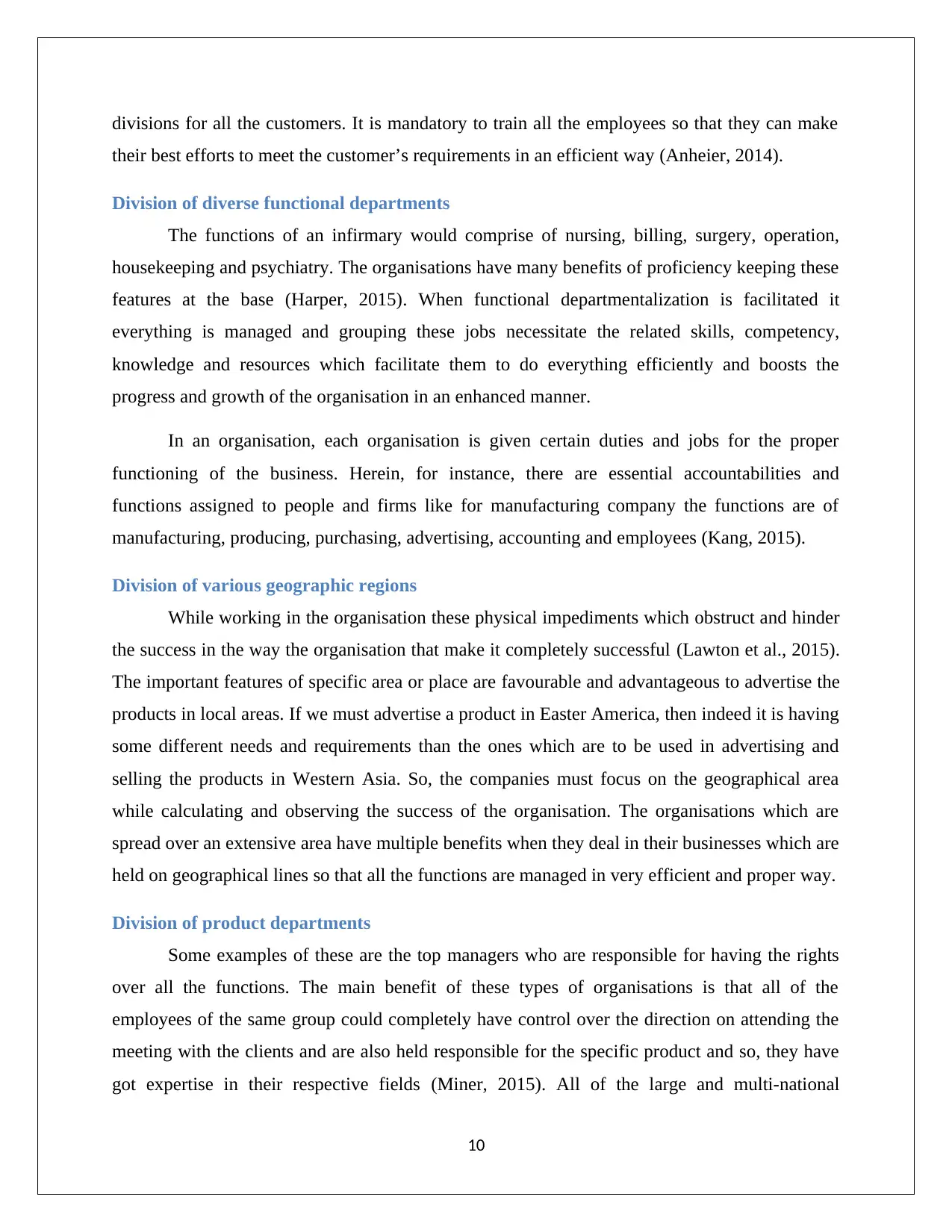
divisions for all the customers. It is mandatory to train all the employees so that they can make
their best efforts to meet the customer’s requirements in an efficient way (Anheier, 2014).
Division of diverse functional departments
The functions of an infirmary would comprise of nursing, billing, surgery, operation,
housekeeping and psychiatry. The organisations have many benefits of proficiency keeping these
features at the base (Harper, 2015). When functional departmentalization is facilitated it
everything is managed and grouping these jobs necessitate the related skills, competency,
knowledge and resources which facilitate them to do everything efficiently and boosts the
progress and growth of the organisation in an enhanced manner.
In an organisation, each organisation is given certain duties and jobs for the proper
functioning of the business. Herein, for instance, there are essential accountabilities and
functions assigned to people and firms like for manufacturing company the functions are of
manufacturing, producing, purchasing, advertising, accounting and employees (Kang, 2015).
Division of various geographic regions
While working in the organisation these physical impediments which obstruct and hinder
the success in the way the organisation that make it completely successful (Lawton et al., 2015).
The important features of specific area or place are favourable and advantageous to advertise the
products in local areas. If we must advertise a product in Easter America, then indeed it is having
some different needs and requirements than the ones which are to be used in advertising and
selling the products in Western Asia. So, the companies must focus on the geographical area
while calculating and observing the success of the organisation. The organisations which are
spread over an extensive area have multiple benefits when they deal in their businesses which are
held on geographical lines so that all the functions are managed in very efficient and proper way.
Division of product departments
Some examples of these are the top managers who are responsible for having the rights
over all the functions. The main benefit of these types of organisations is that all of the
employees of the same group could completely have control over the direction on attending the
meeting with the clients and are also held responsible for the specific product and so, they have
got expertise in their respective fields (Miner, 2015). All of the large and multi-national
10
their best efforts to meet the customer’s requirements in an efficient way (Anheier, 2014).
Division of diverse functional departments
The functions of an infirmary would comprise of nursing, billing, surgery, operation,
housekeeping and psychiatry. The organisations have many benefits of proficiency keeping these
features at the base (Harper, 2015). When functional departmentalization is facilitated it
everything is managed and grouping these jobs necessitate the related skills, competency,
knowledge and resources which facilitate them to do everything efficiently and boosts the
progress and growth of the organisation in an enhanced manner.
In an organisation, each organisation is given certain duties and jobs for the proper
functioning of the business. Herein, for instance, there are essential accountabilities and
functions assigned to people and firms like for manufacturing company the functions are of
manufacturing, producing, purchasing, advertising, accounting and employees (Kang, 2015).
Division of various geographic regions
While working in the organisation these physical impediments which obstruct and hinder
the success in the way the organisation that make it completely successful (Lawton et al., 2015).
The important features of specific area or place are favourable and advantageous to advertise the
products in local areas. If we must advertise a product in Easter America, then indeed it is having
some different needs and requirements than the ones which are to be used in advertising and
selling the products in Western Asia. So, the companies must focus on the geographical area
while calculating and observing the success of the organisation. The organisations which are
spread over an extensive area have multiple benefits when they deal in their businesses which are
held on geographical lines so that all the functions are managed in very efficient and proper way.
Division of product departments
Some examples of these are the top managers who are responsible for having the rights
over all the functions. The main benefit of these types of organisations is that all of the
employees of the same group could completely have control over the direction on attending the
meeting with the clients and are also held responsible for the specific product and so, they have
got expertise in their respective fields (Miner, 2015). All of the large and multi-national
10
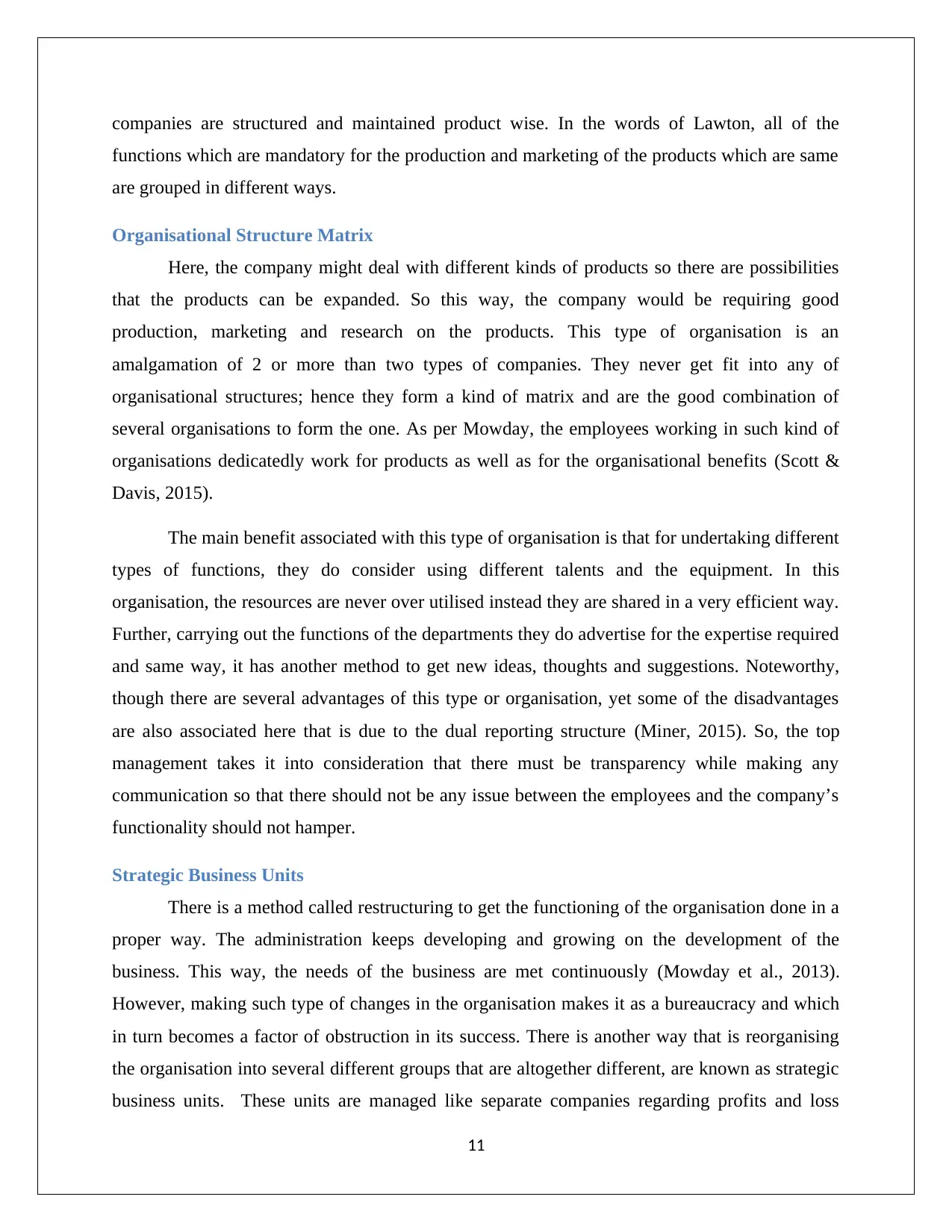
companies are structured and maintained product wise. In the words of Lawton, all of the
functions which are mandatory for the production and marketing of the products which are same
are grouped in different ways.
Organisational Structure Matrix
Here, the company might deal with different kinds of products so there are possibilities
that the products can be expanded. So this way, the company would be requiring good
production, marketing and research on the products. This type of organisation is an
amalgamation of 2 or more than two types of companies. They never get fit into any of
organisational structures; hence they form a kind of matrix and are the good combination of
several organisations to form the one. As per Mowday, the employees working in such kind of
organisations dedicatedly work for products as well as for the organisational benefits (Scott &
Davis, 2015).
The main benefit associated with this type of organisation is that for undertaking different
types of functions, they do consider using different talents and the equipment. In this
organisation, the resources are never over utilised instead they are shared in a very efficient way.
Further, carrying out the functions of the departments they do advertise for the expertise required
and same way, it has another method to get new ideas, thoughts and suggestions. Noteworthy,
though there are several advantages of this type or organisation, yet some of the disadvantages
are also associated here that is due to the dual reporting structure (Miner, 2015). So, the top
management takes it into consideration that there must be transparency while making any
communication so that there should not be any issue between the employees and the company’s
functionality should not hamper.
Strategic Business Units
There is a method called restructuring to get the functioning of the organisation done in a
proper way. The administration keeps developing and growing on the development of the
business. This way, the needs of the business are met continuously (Mowday et al., 2013).
However, making such type of changes in the organisation makes it as a bureaucracy and which
in turn becomes a factor of obstruction in its success. There is another way that is reorganising
the organisation into several different groups that are altogether different, are known as strategic
business units. These units are managed like separate companies regarding profits and loss
11
functions which are mandatory for the production and marketing of the products which are same
are grouped in different ways.
Organisational Structure Matrix
Here, the company might deal with different kinds of products so there are possibilities
that the products can be expanded. So this way, the company would be requiring good
production, marketing and research on the products. This type of organisation is an
amalgamation of 2 or more than two types of companies. They never get fit into any of
organisational structures; hence they form a kind of matrix and are the good combination of
several organisations to form the one. As per Mowday, the employees working in such kind of
organisations dedicatedly work for products as well as for the organisational benefits (Scott &
Davis, 2015).
The main benefit associated with this type of organisation is that for undertaking different
types of functions, they do consider using different talents and the equipment. In this
organisation, the resources are never over utilised instead they are shared in a very efficient way.
Further, carrying out the functions of the departments they do advertise for the expertise required
and same way, it has another method to get new ideas, thoughts and suggestions. Noteworthy,
though there are several advantages of this type or organisation, yet some of the disadvantages
are also associated here that is due to the dual reporting structure (Miner, 2015). So, the top
management takes it into consideration that there must be transparency while making any
communication so that there should not be any issue between the employees and the company’s
functionality should not hamper.
Strategic Business Units
There is a method called restructuring to get the functioning of the organisation done in a
proper way. The administration keeps developing and growing on the development of the
business. This way, the needs of the business are met continuously (Mowday et al., 2013).
However, making such type of changes in the organisation makes it as a bureaucracy and which
in turn becomes a factor of obstruction in its success. There is another way that is reorganising
the organisation into several different groups that are altogether different, are known as strategic
business units. These units are managed like separate companies regarding profits and loss
11
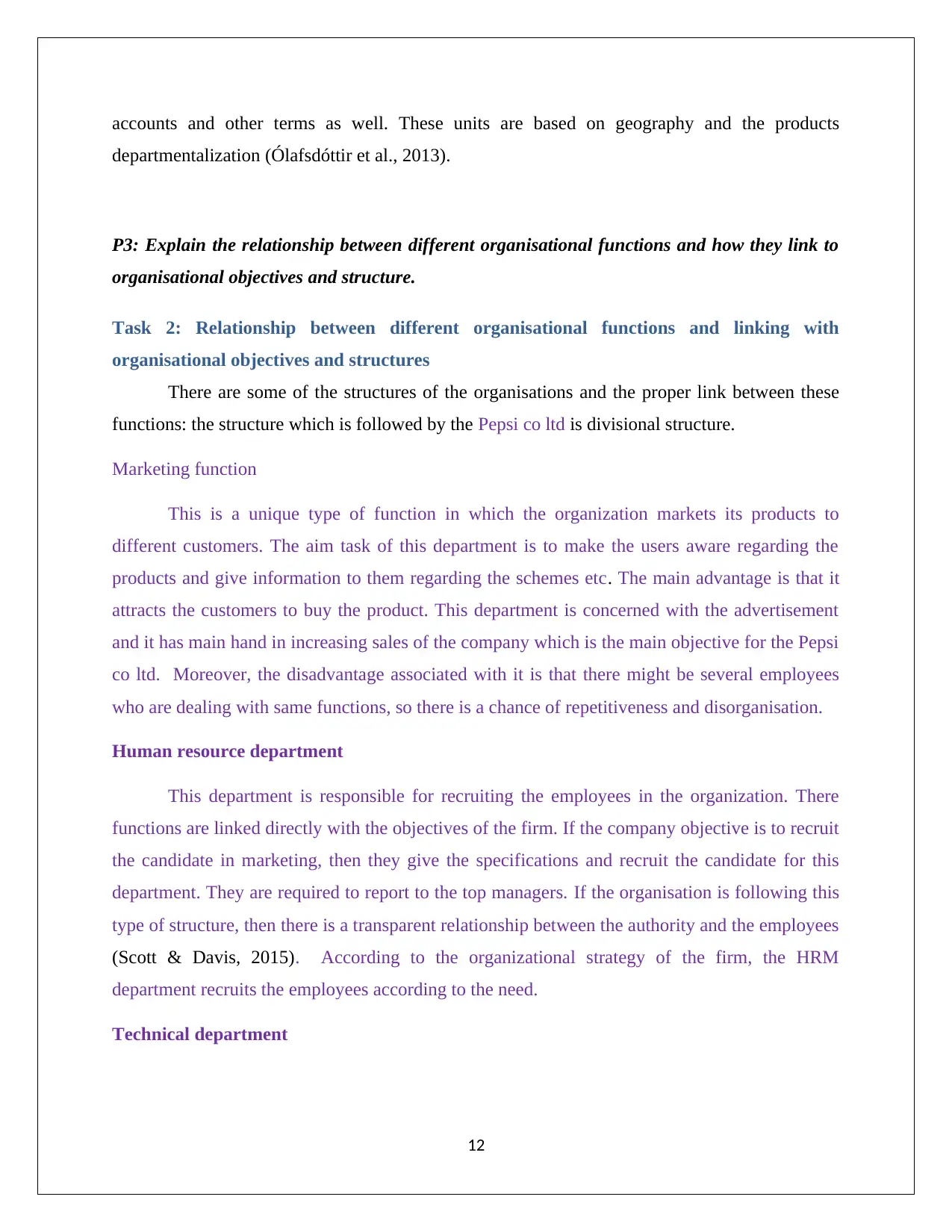
accounts and other terms as well. These units are based on geography and the products
departmentalization (Ólafsdóttir et al., 2013).
P3: Explain the relationship between different organisational functions and how they link to
organisational objectives and structure.
Task 2: Relationship between different organisational functions and linking with
organisational objectives and structures
There are some of the structures of the organisations and the proper link between these
functions: the structure which is followed by the Pepsi co ltd is divisional structure.
Marketing function
This is a unique type of function in which the organization markets its products to
different customers. The aim task of this department is to make the users aware regarding the
products and give information to them regarding the schemes etc. The main advantage is that it
attracts the customers to buy the product. This department is concerned with the advertisement
and it has main hand in increasing sales of the company which is the main objective for the Pepsi
co ltd. Moreover, the disadvantage associated with it is that there might be several employees
who are dealing with same functions, so there is a chance of repetitiveness and disorganisation.
Human resource department
This department is responsible for recruiting the employees in the organization. There
functions are linked directly with the objectives of the firm. If the company objective is to recruit
the candidate in marketing, then they give the specifications and recruit the candidate for this
department. They are required to report to the top managers. If the organisation is following this
type of structure, then there is a transparent relationship between the authority and the employees
(Scott & Davis, 2015). According to the organizational strategy of the firm, the HRM
department recruits the employees according to the need.
Technical department
12
departmentalization (Ólafsdóttir et al., 2013).
P3: Explain the relationship between different organisational functions and how they link to
organisational objectives and structure.
Task 2: Relationship between different organisational functions and linking with
organisational objectives and structures
There are some of the structures of the organisations and the proper link between these
functions: the structure which is followed by the Pepsi co ltd is divisional structure.
Marketing function
This is a unique type of function in which the organization markets its products to
different customers. The aim task of this department is to make the users aware regarding the
products and give information to them regarding the schemes etc. The main advantage is that it
attracts the customers to buy the product. This department is concerned with the advertisement
and it has main hand in increasing sales of the company which is the main objective for the Pepsi
co ltd. Moreover, the disadvantage associated with it is that there might be several employees
who are dealing with same functions, so there is a chance of repetitiveness and disorganisation.
Human resource department
This department is responsible for recruiting the employees in the organization. There
functions are linked directly with the objectives of the firm. If the company objective is to recruit
the candidate in marketing, then they give the specifications and recruit the candidate for this
department. They are required to report to the top managers. If the organisation is following this
type of structure, then there is a transparent relationship between the authority and the employees
(Scott & Davis, 2015). According to the organizational strategy of the firm, the HRM
department recruits the employees according to the need.
Technical department
12
Paraphrase This Document
Need a fresh take? Get an instant paraphrase of this document with our AI Paraphraser
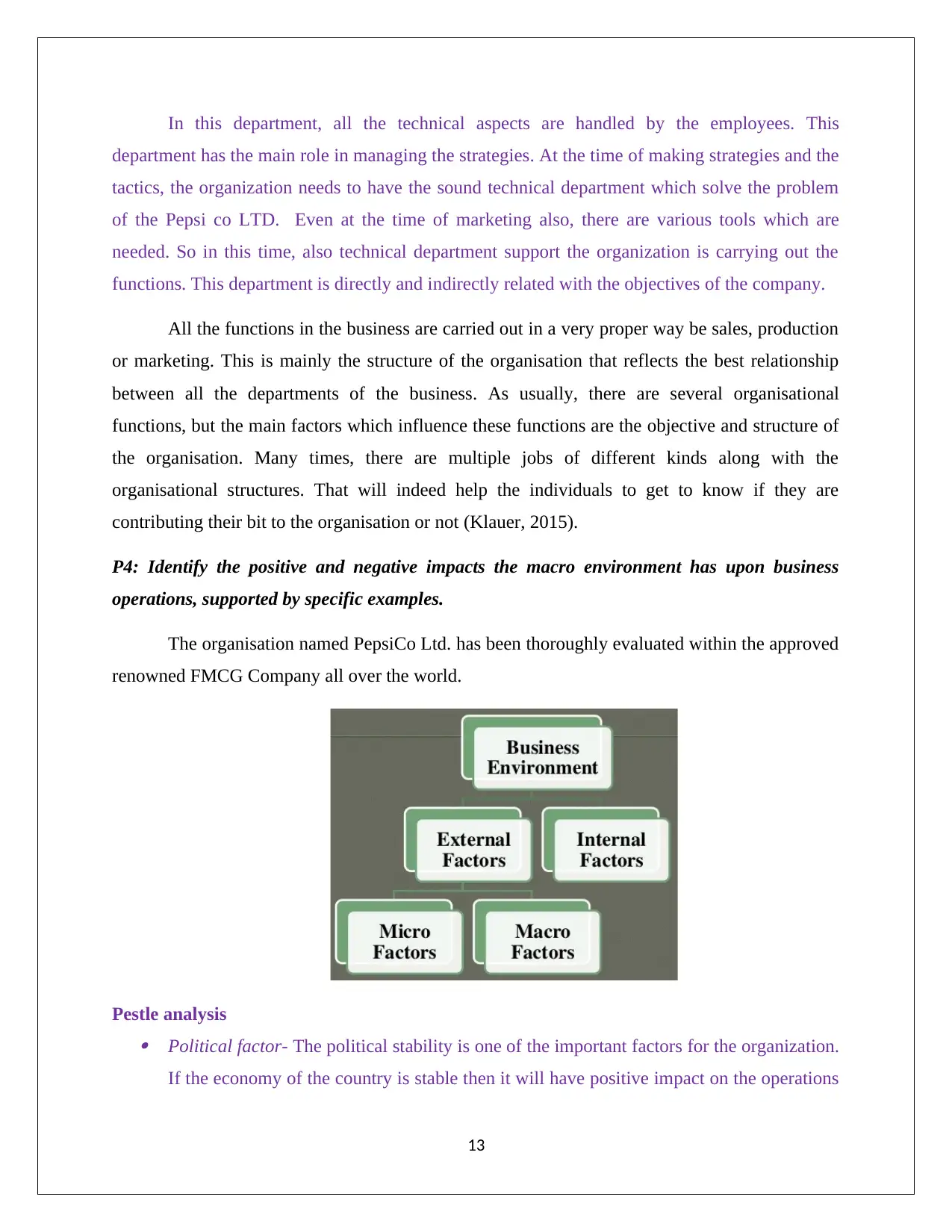
In this department, all the technical aspects are handled by the employees. This
department has the main role in managing the strategies. At the time of making strategies and the
tactics, the organization needs to have the sound technical department which solve the problem
of the Pepsi co LTD. Even at the time of marketing also, there are various tools which are
needed. So in this time, also technical department support the organization is carrying out the
functions. This department is directly and indirectly related with the objectives of the company.
All the functions in the business are carried out in a very proper way be sales, production
or marketing. This is mainly the structure of the organisation that reflects the best relationship
between all the departments of the business. As usually, there are several organisational
functions, but the main factors which influence these functions are the objective and structure of
the organisation. Many times, there are multiple jobs of different kinds along with the
organisational structures. That will indeed help the individuals to get to know if they are
contributing their bit to the organisation or not (Klauer, 2015).
P4: Identify the positive and negative impacts the macro environment has upon business
operations, supported by specific examples.
The organisation named PepsiCo Ltd. has been thoroughly evaluated within the approved
renowned FMCG Company all over the world.
Pestle analysis Political factor- The political stability is one of the important factors for the organization.
If the economy of the country is stable then it will have positive impact on the operations
13
department has the main role in managing the strategies. At the time of making strategies and the
tactics, the organization needs to have the sound technical department which solve the problem
of the Pepsi co LTD. Even at the time of marketing also, there are various tools which are
needed. So in this time, also technical department support the organization is carrying out the
functions. This department is directly and indirectly related with the objectives of the company.
All the functions in the business are carried out in a very proper way be sales, production
or marketing. This is mainly the structure of the organisation that reflects the best relationship
between all the departments of the business. As usually, there are several organisational
functions, but the main factors which influence these functions are the objective and structure of
the organisation. Many times, there are multiple jobs of different kinds along with the
organisational structures. That will indeed help the individuals to get to know if they are
contributing their bit to the organisation or not (Klauer, 2015).
P4: Identify the positive and negative impacts the macro environment has upon business
operations, supported by specific examples.
The organisation named PepsiCo Ltd. has been thoroughly evaluated within the approved
renowned FMCG Company all over the world.
Pestle analysis Political factor- The political stability is one of the important factors for the organization.
If the economy of the country is stable then it will have positive impact on the operations
13
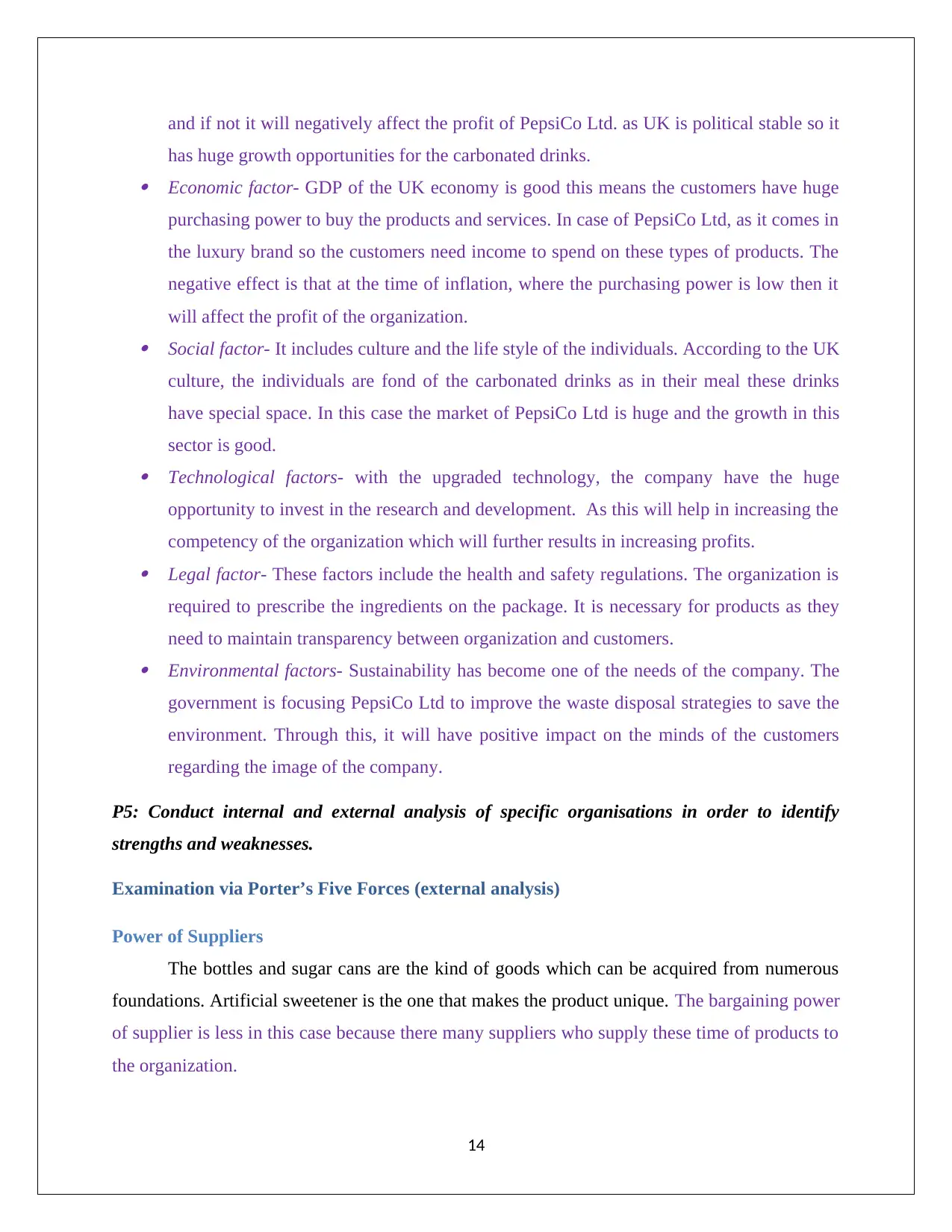
and if not it will negatively affect the profit of PepsiCo Ltd. as UK is political stable so it
has huge growth opportunities for the carbonated drinks. Economic factor- GDP of the UK economy is good this means the customers have huge
purchasing power to buy the products and services. In case of PepsiCo Ltd, as it comes in
the luxury brand so the customers need income to spend on these types of products. The
negative effect is that at the time of inflation, where the purchasing power is low then it
will affect the profit of the organization. Social factor- It includes culture and the life style of the individuals. According to the UK
culture, the individuals are fond of the carbonated drinks as in their meal these drinks
have special space. In this case the market of PepsiCo Ltd is huge and the growth in this
sector is good. Technological factors- with the upgraded technology, the company have the huge
opportunity to invest in the research and development. As this will help in increasing the
competency of the organization which will further results in increasing profits. Legal factor- These factors include the health and safety regulations. The organization is
required to prescribe the ingredients on the package. It is necessary for products as they
need to maintain transparency between organization and customers. Environmental factors- Sustainability has become one of the needs of the company. The
government is focusing PepsiCo Ltd to improve the waste disposal strategies to save the
environment. Through this, it will have positive impact on the minds of the customers
regarding the image of the company.
P5: Conduct internal and external analysis of specific organisations in order to identify
strengths and weaknesses.
Examination via Porter’s Five Forces (external analysis)
Power of Suppliers
The bottles and sugar cans are the kind of goods which can be acquired from numerous
foundations. Artificial sweetener is the one that makes the product unique. The bargaining power
of supplier is less in this case because there many suppliers who supply these time of products to
the organization.
14
has huge growth opportunities for the carbonated drinks. Economic factor- GDP of the UK economy is good this means the customers have huge
purchasing power to buy the products and services. In case of PepsiCo Ltd, as it comes in
the luxury brand so the customers need income to spend on these types of products. The
negative effect is that at the time of inflation, where the purchasing power is low then it
will affect the profit of the organization. Social factor- It includes culture and the life style of the individuals. According to the UK
culture, the individuals are fond of the carbonated drinks as in their meal these drinks
have special space. In this case the market of PepsiCo Ltd is huge and the growth in this
sector is good. Technological factors- with the upgraded technology, the company have the huge
opportunity to invest in the research and development. As this will help in increasing the
competency of the organization which will further results in increasing profits. Legal factor- These factors include the health and safety regulations. The organization is
required to prescribe the ingredients on the package. It is necessary for products as they
need to maintain transparency between organization and customers. Environmental factors- Sustainability has become one of the needs of the company. The
government is focusing PepsiCo Ltd to improve the waste disposal strategies to save the
environment. Through this, it will have positive impact on the minds of the customers
regarding the image of the company.
P5: Conduct internal and external analysis of specific organisations in order to identify
strengths and weaknesses.
Examination via Porter’s Five Forces (external analysis)
Power of Suppliers
The bottles and sugar cans are the kind of goods which can be acquired from numerous
foundations. Artificial sweetener is the one that makes the product unique. The bargaining power
of supplier is less in this case because there many suppliers who supply these time of products to
the organization.
14
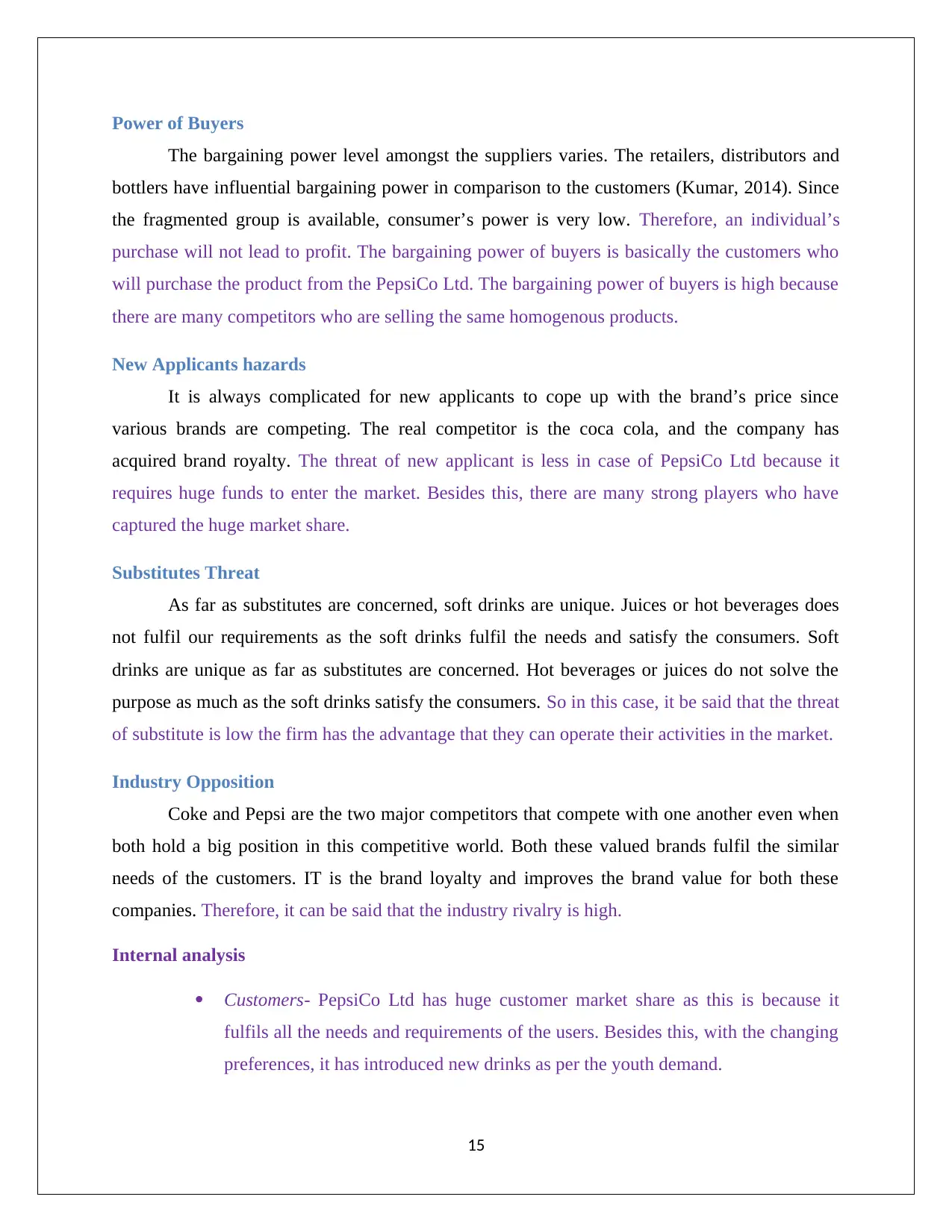
Power of Buyers
The bargaining power level amongst the suppliers varies. The retailers, distributors and
bottlers have influential bargaining power in comparison to the customers (Kumar, 2014). Since
the fragmented group is available, consumer’s power is very low. Therefore, an individual’s
purchase will not lead to profit. The bargaining power of buyers is basically the customers who
will purchase the product from the PepsiCo Ltd. The bargaining power of buyers is high because
there are many competitors who are selling the same homogenous products.
New Applicants hazards
It is always complicated for new applicants to cope up with the brand’s price since
various brands are competing. The real competitor is the coca cola, and the company has
acquired brand royalty. The threat of new applicant is less in case of PepsiCo Ltd because it
requires huge funds to enter the market. Besides this, there are many strong players who have
captured the huge market share.
Substitutes Threat
As far as substitutes are concerned, soft drinks are unique. Juices or hot beverages does
not fulfil our requirements as the soft drinks fulfil the needs and satisfy the consumers. Soft
drinks are unique as far as substitutes are concerned. Hot beverages or juices do not solve the
purpose as much as the soft drinks satisfy the consumers. So in this case, it be said that the threat
of substitute is low the firm has the advantage that they can operate their activities in the market.
Industry Opposition
Coke and Pepsi are the two major competitors that compete with one another even when
both hold a big position in this competitive world. Both these valued brands fulfil the similar
needs of the customers. IT is the brand loyalty and improves the brand value for both these
companies. Therefore, it can be said that the industry rivalry is high.
Internal analysis
Customers- PepsiCo Ltd has huge customer market share as this is because it
fulfils all the needs and requirements of the users. Besides this, with the changing
preferences, it has introduced new drinks as per the youth demand.
15
The bargaining power level amongst the suppliers varies. The retailers, distributors and
bottlers have influential bargaining power in comparison to the customers (Kumar, 2014). Since
the fragmented group is available, consumer’s power is very low. Therefore, an individual’s
purchase will not lead to profit. The bargaining power of buyers is basically the customers who
will purchase the product from the PepsiCo Ltd. The bargaining power of buyers is high because
there are many competitors who are selling the same homogenous products.
New Applicants hazards
It is always complicated for new applicants to cope up with the brand’s price since
various brands are competing. The real competitor is the coca cola, and the company has
acquired brand royalty. The threat of new applicant is less in case of PepsiCo Ltd because it
requires huge funds to enter the market. Besides this, there are many strong players who have
captured the huge market share.
Substitutes Threat
As far as substitutes are concerned, soft drinks are unique. Juices or hot beverages does
not fulfil our requirements as the soft drinks fulfil the needs and satisfy the consumers. Soft
drinks are unique as far as substitutes are concerned. Hot beverages or juices do not solve the
purpose as much as the soft drinks satisfy the consumers. So in this case, it be said that the threat
of substitute is low the firm has the advantage that they can operate their activities in the market.
Industry Opposition
Coke and Pepsi are the two major competitors that compete with one another even when
both hold a big position in this competitive world. Both these valued brands fulfil the similar
needs of the customers. IT is the brand loyalty and improves the brand value for both these
companies. Therefore, it can be said that the industry rivalry is high.
Internal analysis
Customers- PepsiCo Ltd has huge customer market share as this is because it
fulfils all the needs and requirements of the users. Besides this, with the changing
preferences, it has introduced new drinks as per the youth demand.
15
Secure Best Marks with AI Grader
Need help grading? Try our AI Grader for instant feedback on your assignments.

Stakeholders- They are the one who provide them with finance which is required
by the organization. To satisfy them, the organization is required to provide them
with profits and involve them in decision making of the firm.
Employees- PepsiCo Ltd is required to provide their employee with clean
environment and proper working condition. As it has been witnessed that the
employees of the organization are dedicated towards functions of the organization
which has helped the firm in developing competitive advantage.
P6: Explain how strengths and weaknesses interrelate with external macro factors
Strengths
There have been many such cases against the company which have affected the brand
image of the company.There is an immensely growing competition in the aerated drinks section
such as Coca Cola which is its biggest competitor and there is a brand switching which takes
place that is a weak point for the company (Baker, 2012).
Strong points
In the food and beverage section, the company is a reputed and renowned, recognised and
well-acknowledged brand. It incorporates through an expanded portfolio. It possesses some
subsidiary brands like Tropicana, Pepsi and Gatorade, etc. There are several CSR activities
which will take place and work by the health, water conservation and education area. The
company has strong coverage of more than 200 countries at International level and covering
more than 300,000 people all over the Globe. The company has a competently accomplished
supply chain network ensuring that the existing products are easily accessible even from the
remote locations. The advertising and branding of the product are equally important like
collaborations, music concerts, and sponsorships at events along with many more similar aspects.
Besides this, as the company has expanded its operations in different areas, so it is required to
comply with all rules and regulations of the particular country. As all countries have diverse laws
according to their business environment.
16
by the organization. To satisfy them, the organization is required to provide them
with profits and involve them in decision making of the firm.
Employees- PepsiCo Ltd is required to provide their employee with clean
environment and proper working condition. As it has been witnessed that the
employees of the organization are dedicated towards functions of the organization
which has helped the firm in developing competitive advantage.
P6: Explain how strengths and weaknesses interrelate with external macro factors
Strengths
There have been many such cases against the company which have affected the brand
image of the company.There is an immensely growing competition in the aerated drinks section
such as Coca Cola which is its biggest competitor and there is a brand switching which takes
place that is a weak point for the company (Baker, 2012).
Strong points
In the food and beverage section, the company is a reputed and renowned, recognised and
well-acknowledged brand. It incorporates through an expanded portfolio. It possesses some
subsidiary brands like Tropicana, Pepsi and Gatorade, etc. There are several CSR activities
which will take place and work by the health, water conservation and education area. The
company has strong coverage of more than 200 countries at International level and covering
more than 300,000 people all over the Globe. The company has a competently accomplished
supply chain network ensuring that the existing products are easily accessible even from the
remote locations. The advertising and branding of the product are equally important like
collaborations, music concerts, and sponsorships at events along with many more similar aspects.
Besides this, as the company has expanded its operations in different areas, so it is required to
comply with all rules and regulations of the particular country. As all countries have diverse laws
according to their business environment.
16

Existing and upcoming prospects
There is a growing need for beverages and snacks since it is being consumed largely in
the emerging markets. There is augmenting demand for healthy beverages and food. So, the
company can expand through its acquisitions, bottled water consumption is in much demand, and
there are many prospects for increased penetration in developing countries to capture more and
more market possible (Döckel & Ligthelm, 2015). There can be more and more CSR activities
which the company can follow since its brand image has been affected due to some cases. With
the analysis it can be witnessed that the social needs for these factors is increasing which is
beneficial for the organization. As the change in the needs and expectations of the customers are
in favour of the firm.
Threats
The people are becoming more health conscious. Therefore, the aerated drinks and snacks
have become their last choice for them. Nowadays, uncertainty and economic challenges are few
things that may decline in the purchasing power for the customers. There is an unwavering
competition running among various big competing brands. The changing consumer tastes and
decrease in the gross profit margin is an additional concern for the company (Ólafsdóttir et al.,
2013).
Weakness
The major weakness of the Pepsi co is that they have not targeted the health conscious
people with the drinks. With the change in preferences, the people are becoming health
conscious so to build huge profit they are required to target them to capture the huge market area.
Conclusion
The organisational structure and objectives are highlighted. PESTLE and SWOT Analysis is also
carried out. The desirable and undesirable effect on the international level must be evaluated
thoroughly. The organisational structures should be compatible with the organisation positions.
The people should be organised so that they can execute their responsibilities appropriately
considering the overall objectives of the company and employees. There are various diverse
environmental aspects that influence the businesses competence for delivering services to the
17
There is a growing need for beverages and snacks since it is being consumed largely in
the emerging markets. There is augmenting demand for healthy beverages and food. So, the
company can expand through its acquisitions, bottled water consumption is in much demand, and
there are many prospects for increased penetration in developing countries to capture more and
more market possible (Döckel & Ligthelm, 2015). There can be more and more CSR activities
which the company can follow since its brand image has been affected due to some cases. With
the analysis it can be witnessed that the social needs for these factors is increasing which is
beneficial for the organization. As the change in the needs and expectations of the customers are
in favour of the firm.
Threats
The people are becoming more health conscious. Therefore, the aerated drinks and snacks
have become their last choice for them. Nowadays, uncertainty and economic challenges are few
things that may decline in the purchasing power for the customers. There is an unwavering
competition running among various big competing brands. The changing consumer tastes and
decrease in the gross profit margin is an additional concern for the company (Ólafsdóttir et al.,
2013).
Weakness
The major weakness of the Pepsi co is that they have not targeted the health conscious
people with the drinks. With the change in preferences, the people are becoming health
conscious so to build huge profit they are required to target them to capture the huge market area.
Conclusion
The organisational structure and objectives are highlighted. PESTLE and SWOT Analysis is also
carried out. The desirable and undesirable effect on the international level must be evaluated
thoroughly. The organisational structures should be compatible with the organisation positions.
The people should be organised so that they can execute their responsibilities appropriately
considering the overall objectives of the company and employees. There are various diverse
environmental aspects that influence the businesses competence for delivering services to the
17
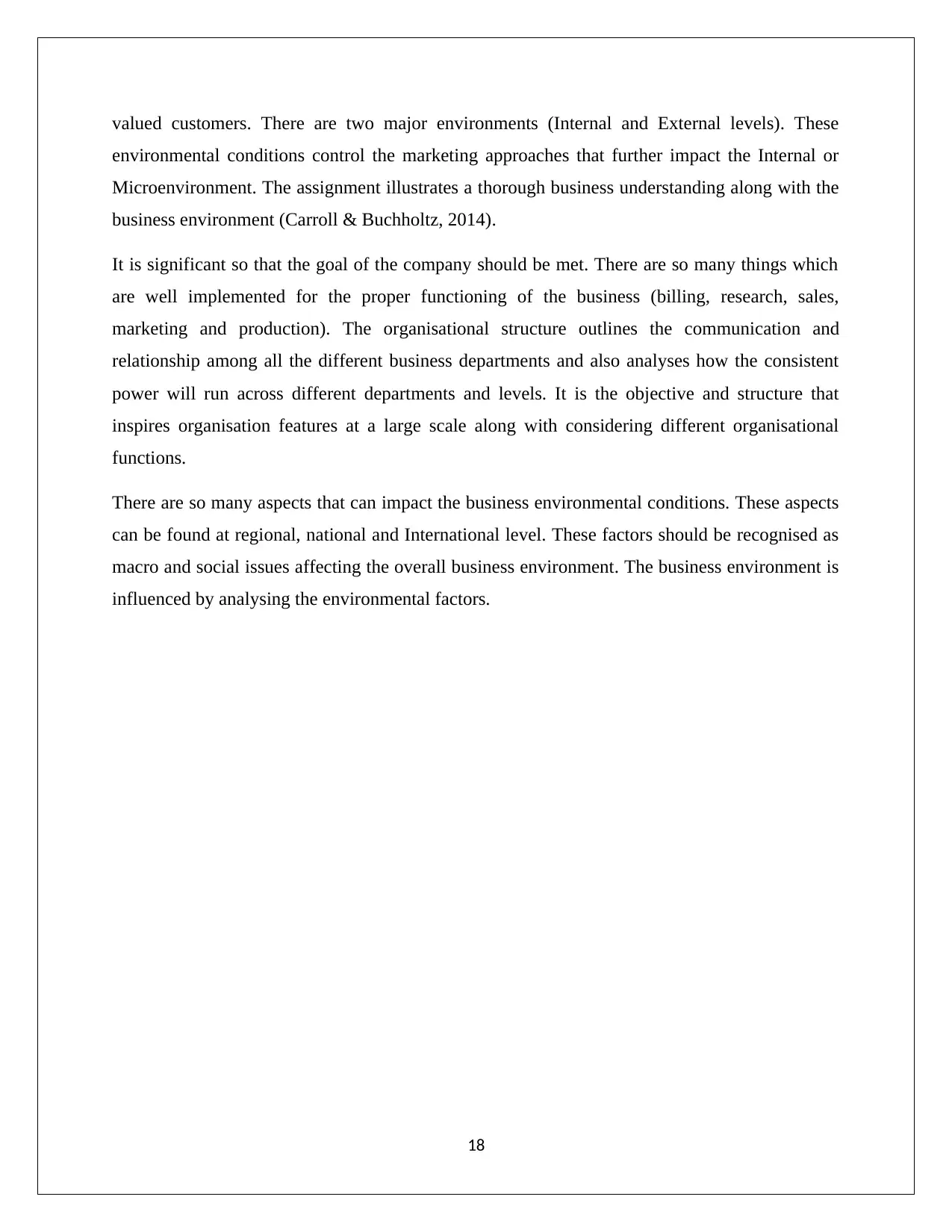
valued customers. There are two major environments (Internal and External levels). These
environmental conditions control the marketing approaches that further impact the Internal or
Microenvironment. The assignment illustrates a thorough business understanding along with the
business environment (Carroll & Buchholtz, 2014).
It is significant so that the goal of the company should be met. There are so many things which
are well implemented for the proper functioning of the business (billing, research, sales,
marketing and production). The organisational structure outlines the communication and
relationship among all the different business departments and also analyses how the consistent
power will run across different departments and levels. It is the objective and structure that
inspires organisation features at a large scale along with considering different organisational
functions.
There are so many aspects that can impact the business environmental conditions. These aspects
can be found at regional, national and International level. These factors should be recognised as
macro and social issues affecting the overall business environment. The business environment is
influenced by analysing the environmental factors.
18
environmental conditions control the marketing approaches that further impact the Internal or
Microenvironment. The assignment illustrates a thorough business understanding along with the
business environment (Carroll & Buchholtz, 2014).
It is significant so that the goal of the company should be met. There are so many things which
are well implemented for the proper functioning of the business (billing, research, sales,
marketing and production). The organisational structure outlines the communication and
relationship among all the different business departments and also analyses how the consistent
power will run across different departments and levels. It is the objective and structure that
inspires organisation features at a large scale along with considering different organisational
functions.
There are so many aspects that can impact the business environmental conditions. These aspects
can be found at regional, national and International level. These factors should be recognised as
macro and social issues affecting the overall business environment. The business environment is
influenced by analysing the environmental factors.
18
Paraphrase This Document
Need a fresh take? Get an instant paraphrase of this document with our AI Paraphraser
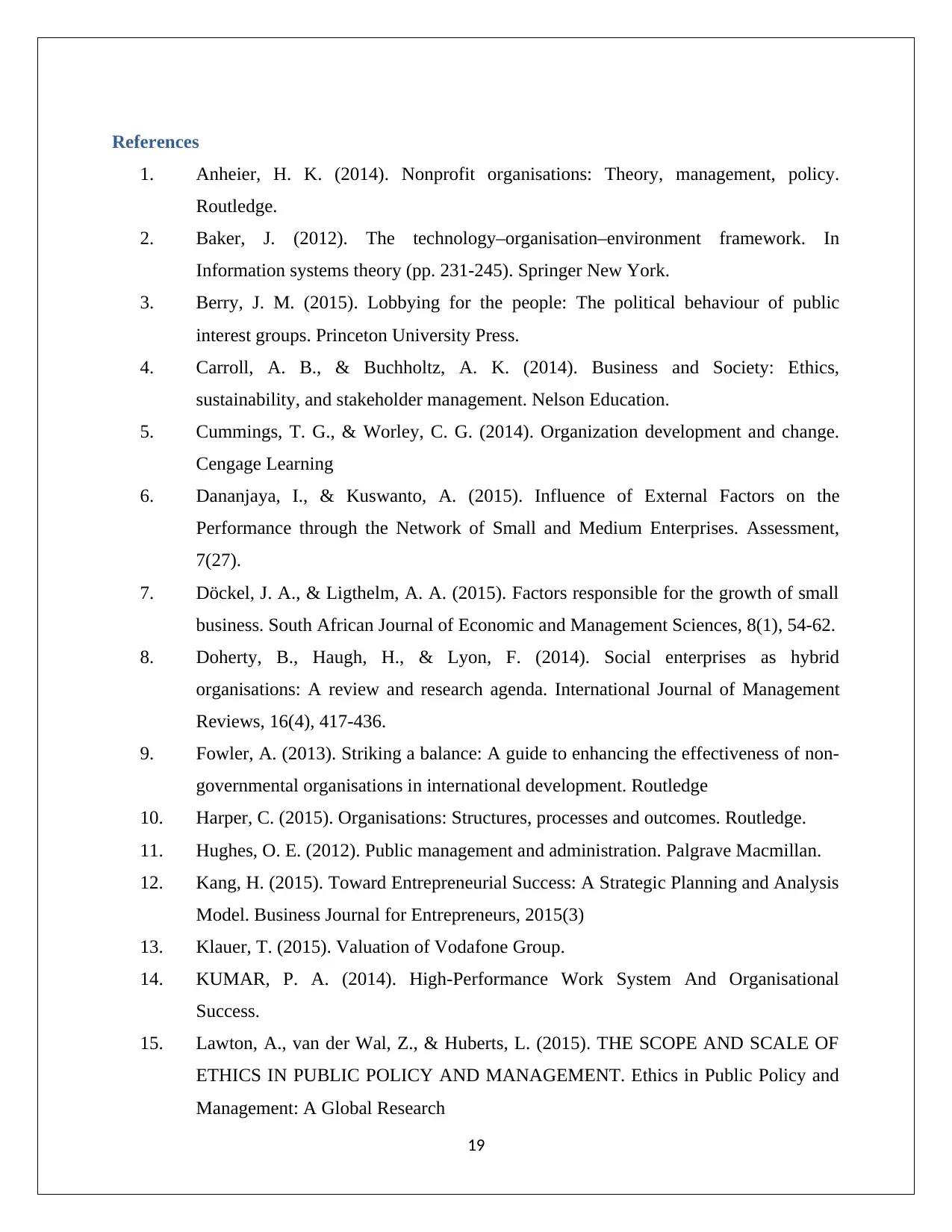
References
1. Anheier, H. K. (2014). Nonprofit organisations: Theory, management, policy.
Routledge.
2. Baker, J. (2012). The technology–organisation–environment framework. In
Information systems theory (pp. 231-245). Springer New York.
3. Berry, J. M. (2015). Lobbying for the people: The political behaviour of public
interest groups. Princeton University Press.
4. Carroll, A. B., & Buchholtz, A. K. (2014). Business and Society: Ethics,
sustainability, and stakeholder management. Nelson Education.
5. Cummings, T. G., & Worley, C. G. (2014). Organization development and change.
Cengage Learning
6. Dananjaya, I., & Kuswanto, A. (2015). Influence of External Factors on the
Performance through the Network of Small and Medium Enterprises. Assessment,
7(27).
7. Döckel, J. A., & Ligthelm, A. A. (2015). Factors responsible for the growth of small
business. South African Journal of Economic and Management Sciences, 8(1), 54-62.
8. Doherty, B., Haugh, H., & Lyon, F. (2014). Social enterprises as hybrid
organisations: A review and research agenda. International Journal of Management
Reviews, 16(4), 417-436.
9. Fowler, A. (2013). Striking a balance: A guide to enhancing the effectiveness of non-
governmental organisations in international development. Routledge
10. Harper, C. (2015). Organisations: Structures, processes and outcomes. Routledge.
11. Hughes, O. E. (2012). Public management and administration. Palgrave Macmillan.
12. Kang, H. (2015). Toward Entrepreneurial Success: A Strategic Planning and Analysis
Model. Business Journal for Entrepreneurs, 2015(3)
13. Klauer, T. (2015). Valuation of Vodafone Group.
14. KUMAR, P. A. (2014). High-Performance Work System And Organisational
Success.
15. Lawton, A., van der Wal, Z., & Huberts, L. (2015). THE SCOPE AND SCALE OF
ETHICS IN PUBLIC POLICY AND MANAGEMENT. Ethics in Public Policy and
Management: A Global Research
19
1. Anheier, H. K. (2014). Nonprofit organisations: Theory, management, policy.
Routledge.
2. Baker, J. (2012). The technology–organisation–environment framework. In
Information systems theory (pp. 231-245). Springer New York.
3. Berry, J. M. (2015). Lobbying for the people: The political behaviour of public
interest groups. Princeton University Press.
4. Carroll, A. B., & Buchholtz, A. K. (2014). Business and Society: Ethics,
sustainability, and stakeholder management. Nelson Education.
5. Cummings, T. G., & Worley, C. G. (2014). Organization development and change.
Cengage Learning
6. Dananjaya, I., & Kuswanto, A. (2015). Influence of External Factors on the
Performance through the Network of Small and Medium Enterprises. Assessment,
7(27).
7. Döckel, J. A., & Ligthelm, A. A. (2015). Factors responsible for the growth of small
business. South African Journal of Economic and Management Sciences, 8(1), 54-62.
8. Doherty, B., Haugh, H., & Lyon, F. (2014). Social enterprises as hybrid
organisations: A review and research agenda. International Journal of Management
Reviews, 16(4), 417-436.
9. Fowler, A. (2013). Striking a balance: A guide to enhancing the effectiveness of non-
governmental organisations in international development. Routledge
10. Harper, C. (2015). Organisations: Structures, processes and outcomes. Routledge.
11. Hughes, O. E. (2012). Public management and administration. Palgrave Macmillan.
12. Kang, H. (2015). Toward Entrepreneurial Success: A Strategic Planning and Analysis
Model. Business Journal for Entrepreneurs, 2015(3)
13. Klauer, T. (2015). Valuation of Vodafone Group.
14. KUMAR, P. A. (2014). High-Performance Work System And Organisational
Success.
15. Lawton, A., van der Wal, Z., & Huberts, L. (2015). THE SCOPE AND SCALE OF
ETHICS IN PUBLIC POLICY AND MANAGEMENT. Ethics in Public Policy and
Management: A Global Research
19
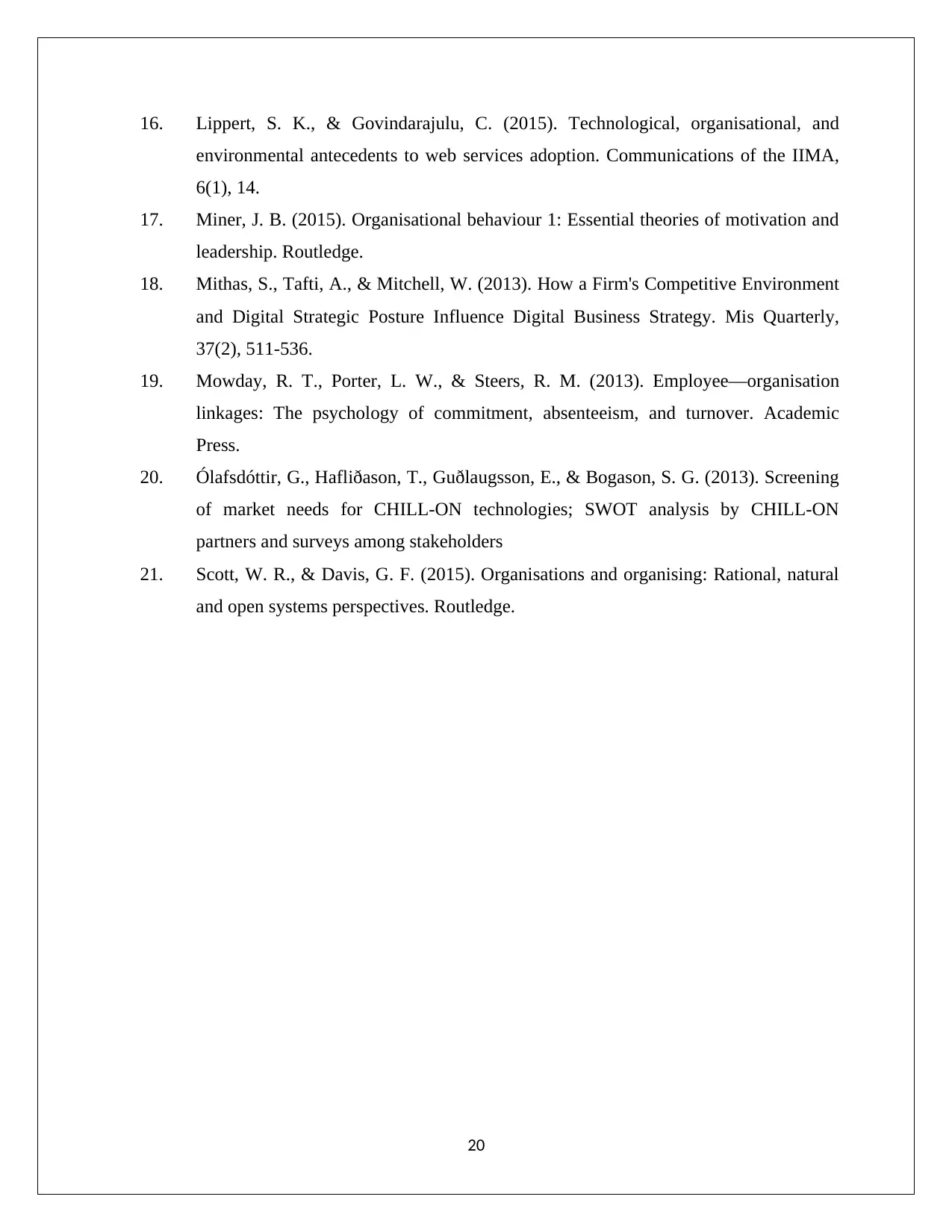
16. Lippert, S. K., & Govindarajulu, C. (2015). Technological, organisational, and
environmental antecedents to web services adoption. Communications of the IIMA,
6(1), 14.
17. Miner, J. B. (2015). Organisational behaviour 1: Essential theories of motivation and
leadership. Routledge.
18. Mithas, S., Tafti, A., & Mitchell, W. (2013). How a Firm's Competitive Environment
and Digital Strategic Posture Influence Digital Business Strategy. Mis Quarterly,
37(2), 511-536.
19. Mowday, R. T., Porter, L. W., & Steers, R. M. (2013). Employee—organisation
linkages: The psychology of commitment, absenteeism, and turnover. Academic
Press.
20. Ólafsdóttir, G., Hafliðason, T., Guðlaugsson, E., & Bogason, S. G. (2013). Screening
of market needs for CHILL-ON technologies; SWOT analysis by CHILL-ON
partners and surveys among stakeholders
21. Scott, W. R., & Davis, G. F. (2015). Organisations and organising: Rational, natural
and open systems perspectives. Routledge.
20
environmental antecedents to web services adoption. Communications of the IIMA,
6(1), 14.
17. Miner, J. B. (2015). Organisational behaviour 1: Essential theories of motivation and
leadership. Routledge.
18. Mithas, S., Tafti, A., & Mitchell, W. (2013). How a Firm's Competitive Environment
and Digital Strategic Posture Influence Digital Business Strategy. Mis Quarterly,
37(2), 511-536.
19. Mowday, R. T., Porter, L. W., & Steers, R. M. (2013). Employee—organisation
linkages: The psychology of commitment, absenteeism, and turnover. Academic
Press.
20. Ólafsdóttir, G., Hafliðason, T., Guðlaugsson, E., & Bogason, S. G. (2013). Screening
of market needs for CHILL-ON technologies; SWOT analysis by CHILL-ON
partners and surveys among stakeholders
21. Scott, W. R., & Davis, G. F. (2015). Organisations and organising: Rational, natural
and open systems perspectives. Routledge.
20

21
1 out of 22
Related Documents
Your All-in-One AI-Powered Toolkit for Academic Success.
+13062052269
info@desklib.com
Available 24*7 on WhatsApp / Email
![[object Object]](/_next/static/media/star-bottom.7253800d.svg)
Unlock your academic potential
© 2024 | Zucol Services PVT LTD | All rights reserved.





